Articles
Geochronology and lithogeochemistry of granitoid rocks from the central part of the Central plutonic belt, New Brunswick, Canada:
implications for Sn-W-Mo exploration
ABSTRACT
The central part of the Central plutonic belt in New Brunswick is underlain by numerous plutons of calc-alkaline, foliated and unfoliated granite that intrude Cambrian to Early Ordovician metasedimentary rocks. U-Pb (zircon) dating demonstrates that granites range in age from Middle Ordovician to Late Devonian, although most are late Silurian to Early Devonian. An age of 467 ± 7 Ma has been obtained on the foliated McKiel Lake Granite, whereas unfoliated intrusions yield ages of 423.2 ± 3.2 Ma (Bogan Brook Granodiorite), 420.7 +1.8/-2.0 Ma (Nashwaak Granite), 419.0 ± 0.5 Ma (Redstone Mountain Granite), 416.1 ± 0.5 Ma (Beadle Mountain Granite), 415.8 ± 0.3 Ma (Juniper Barren Granite), 409.7 ± 0.5 Ma (Lost Lake Granite), and 380.6 ± 0.3 Ma (Burnthill Granite). All plutons exhibit mixed arc-like and within-plate geochemical signatures, although the Redstone Mountain and Burnthill granites are dominantly within-plate type. Trace element data reveal a close overall geochemical similarity between Ordovician and Silurian – Devonian plutons, indicating that all were generated by partial melting of similar crustal sources and/or share a similar petrogenesis. Late Silurian to Early Devonian plutons mainly comprise biotite and/or muscovite-bearing, peraluminous granite and are considered prospective for granophile-element mineralization. All plutons contain Sn well in excess of the granite global average abundance, and several contain average tin values comparable to productive stanniferous granites elsewhere. The Burnthill, Lost Lake, Beadle Mountain and Nashwaak granites are geochemically most evolved and enriched in Sn and W. The Burnthill Granite in particular has experienced late-stage hydrothermal processes that have resulted in local enrichments of these elements.
RÉSUMÉ
La portion centrale de la ceinture plutonique centrale du NouveauBrunswick comporte de nombreux plutons de granites calco-alcalins, foliés et non foliés, qui font intrusion dans des roches métasédimentaires datant du Cambrien à l’Ordovicien précoce. Une datation UPb sur zircon révèle que les granites datent de l’Ordovicien moyen au Dévonien tardif, mais du Silurien tardif au Dévonien précoce pour la plupart. Le granite folié du lac McKiel est âgé de 467 ± 7 Ma, alors que les intrusions non foliées remontent à 423,2 ± 3,2 Ma (granodiorite du ruisseau Bogan), à 420,7 + 1,8/-2,0 Ma (granite de Nashwaak), à 419,0 ± 0,5 Ma (granite du mont Redstone, à 416,1 ± 0,5 Ma (granite du mont Beadle), à 415,8 ± 0,3 Ma (granite de Juniper Barren), à 409,7 ± 0,5 Ma (granite du lac Lost) et à 380,6 ± 0,3 Ma (granite de Burnthill). Tous les plutons présentent des signatures géochimiques en forme d’arc et intraplaques mixtes, bien que les granites du mont Redstone et de Burnthill soient surtout de type intraplaque.Les données sur les éléments traces des plutons de l’Ordovicien et du SilurienDévonien présentent une similitude géochimique globale étroite, ce qui indique qu’ils proviennent tous de la fusion partielle de sources crustales similaires et/ou partagent une pétrogenèse similaire. Les plutons du Silurien tardif au Dévonien précoce sont surtout des granites hyperalumineux à biotite et/ou muscovite et abritent potentiellement des minéralisations d’éléments granophiles. Tous les plutons contiennent des teneurs en Sn très supérieures à l’abondance moyenne générale des granites et plusieurs affichent des valeurs moyennes d’étain comparables à celles des granites stannifères productifs observés ailleurs. Les granites de Burnthill, du lac Lost, du mont Beadle et de Nashwaak sont les plus évolués sur le plan géochimique et les plus riches en Sn et en W. Le granite de Burnthill en particulier a connu des processus hydrothermaux de phase tardive qui ont abouti à des enrichissements locaux de ces éléments.
[Traduit par la redaction]
INTRODUCTION
1 The Central plutonic belt comprises mainly granitoid rocks that underlie a large area of central New Brunswick. They intruded Cambrian-Ordovician rocks of the Miramichi Group and Trousers Lake Metamorphic Suite in a ~250 km-long belt trending north-northeast that extends from the Maine border in southwestern New Brunswick to Chaleur Bay in the northeast (Fig. 1). Ranging in age from Early Ordovician to Late Devonian, these intrusive rocks are predominantly granites, and include several plutonic complexes of batholithic proportions, along with numerous smaller plutons (Fig. 1). The genetic association of some of these plutons with economic or potentially economic concentrations of elements such as Sn, W, Mo, Cu, Sb, In, Be, and Au, has been known for many years (Ruitenberg and Fyffe 1982, and references therein).
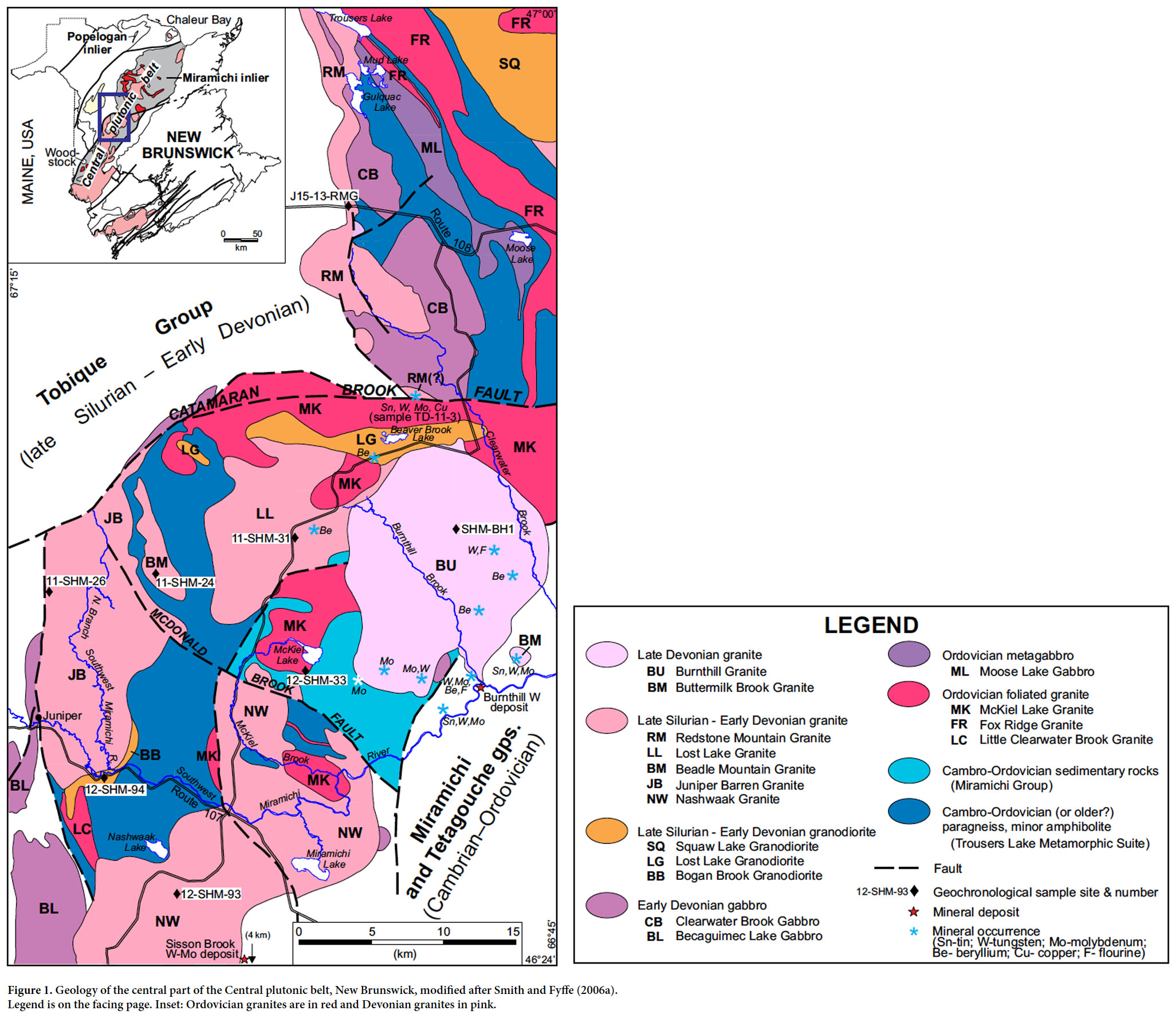 Display large image of Figure 1
Display large image of Figure 1
2 A comprehensive study of granites from the Appalachian orogen in New Brunswick and the Gaspé Peninsula of Québec, including geological, petrographic, geochemical, isotopic and geochronological work, was carried out by the Geological Survey of Canada in the 1980s (Whalen 1993; Whalen et al. 1994, 1996, 1998). Almost all granitoid intrusive rocks in New Brunswick were sampled at that time, although difficulties involving access and exposure meant that some plutons, including most of the granites discussed herein, were only examined at a “reconnaissance” level. Geochronological work carried out during this and previous studies included K-Ar and Rb-Sr dating of the Redstone Mountain, Lost Lake, McKiel Lake, Bogan Brook and Nashwaak intrusions (Fyffe and Cormier 1979; Poole 1980; Bevier and Whalen 1990; Whalen and Theriault 1990), and 40Ar/39Ar dating of the Burnthill Granite (Taylor et al. 1987). More recently, attention was focused on New Brunswick granites and associated intrusion-related mineralization during the 2010–2015 federal–provincial Targeted Geoscience Initiative-4 (TGI-4) project (Rogers 2011), the purpose of which was to identify and evaluate “fertile” intrusions and vectors to additional W, Mo, Sn and other deposits. In the central part of the Central plutonic belt (Fig. 1), TGI-4 field work conducted by the New Brunswick Geological Surveys Branch centred on supplementing the Whalen (1993) database with the acquisition of additional lithogeochemical and geochronological analyses, and on producing improved geological maps for an area characterized by very poor bedrock exposure. This paper presents the results of new lithogeochemical analyses from ten plutons, and crystallization ages determined by Chemical Abrasion–Isotope Dilution–Thermal Ionization Mass Spectrometry (CA-ID-TIMS) for eight of those plutons. These data form the basis of inferences regarding the potential for economic concentrations of granite-related mineralization in some of these intrusive rocks.
OVERVIEW OF REGIONAL GEOLOGY
3 The Central plutonic belt is situated almost entirely within the Miramichi inlier (Fig. 1), which comprises Cambrian to Ordovician stratified rocks of the Miramichi, Woodstock, and Meductic groups, the Bathurst Supergroup, and the Trousers Lake Metamorphic Suite. The Miramichi Group and correlative rocks of the Woodstock Group were deposited as a clastic apron on the passive margin of Ganderia following the late Neoproterozoic opening of the Iapetus Ocean and rifting of the Ganderian continental block from Amazonia (van Staal et al. 2009, 2012). The Trousers Lake Metamorphic Suite (Fyffe et al. 1988) underlies a 15–20 kmwide belt in the core of the Miramichi inlier; paragneiss that dominates this unit is generally interpreted as part of the Miramichi Group that was subjected to amphibolite-facies conditions, and juxtaposed against lower-grade Miramichi rocks along thrust or reverse fault(s) (Fyffe et al. 1988; McClenaghan et al. 2014). The Trousers Lake suite also includes minor amphibolite (metabasalt and metagabbro) and felsic orthogneiss that have been correlated with volcanic rocks of the Bathurst Supergroup (Fyffe et al. 1988; Winchester et al. 1992). The Bathurst Supergroup comprises volcanic and sedimentary rocks that were deposited during extension and rifting of the Early to Middle Ordovician, ensialic Popelogan arc, leading to opening of the Tetagouche backarc basin (van Staal et al. 2003, 2016). Early Ordovician, pre-rifting volcanic rocks of the Popelogan arc are exposed in the southwestern part of the Miramichi inlier near Woodstock, where they are assigned to the Meductic Group (Fyffe 2001), whereas Middle Ordovician, postrifting arc volcanic rocks are exposed in the Popelogan inlier in northern New Brunswick and assigned to the Balmoral Group (Wilson 2003) (Fig. 1 inset). All of these units were accreted to the Laurentian margin during the Salinic (Silurian) and Acadian (Devonian) orogenic cycles (van Staal and de Roo 1995; van Staal et al. 2003, 2009).
4 The oldest plutonic rocks in the Central plutonic belt are foliated granites that generally yield Floian to Darriwilian (Early to Middle Ordovician) U-Pb (zircon) ages (Whalen 1993; Whalen et al. 1998; McNicoll et al. 2003). For most of these intrusions, within-plate-like chemical signatures (Whalen 1993) strongly imply that they are plutonic equivalents of the backarc volcanic rocks of the Bathurst Supergroup. However, foliated granites with Early Ordovician ages predate backarc volcanism, suggesting correlation with arc volcanic rocks of the Meductic Group, although, except for the Gibson and Benton plutons in the Woodstock area (Whalen et al. 1998), these granites lack typical arc-like geochemical signatures. In the central part of the Central plutonic belt, the Fox Ridge Granite (Fig. 1; not sampled in this study) and felsic orthogneiss from the Trousers Lake Metamorphic Suite have yielded U-Pb (zircon) ages of 451 +15/-1 Ma and 434 +29/-6 Ma, respectively (Fyffe et al. 1988); the older limits of these error ranges place both units in the Darriwilian, like most other Ordovician granites in the Miramichi inlier. In the study area, most foliated felsic intrusions are assigned to the McKiel Lake Granite, which, in addition to exposures in the type area at McKiel Lake, includes a large body on the south side of the Catamaran Brook Fault that was probably originally (prior to Silurian–Devonian plutonism) contiguous with foliated granite in the upper part of Burnthill Brook (Fig. 1), and a smaller pluton on the lower part of McKiel Brook (Fig. 1) that Poole (1980) informally referred to as the “Sugar granite”.
5 Most plutonic rocks in the study area are unfoliated granites. Based on previously acquired Rb-Sr and K-Ar ages (Fyffe and Cormier 1979; Poole 1980; Bevier and Whalen 1990; Whalen and Theriault 1990; see below), and U-Pb zircon and monazite ages from similar plutonic suites farther north (Bevier and Whalen 1990), these granites have been assumed to range in age from late Silurian to Early Devonian. Included in this group are the Lost Lake, Beadle Mountain, Juniper Barren, Nashwaak, and Redstone Mountain granites. Associated and generally smaller bodies of granodiorite (Lost Lake and Bogan Brook granodiorites) display a similar range of K-Ar and Rb-Sr ages but commonly have a weak foliation (Poole 1980; St. Peter 1981; Lutes 1981; Crouse 1981a). The Burnthill Granite clearly intruded the Lost Lake Granite, and supported by the results of previous 40Ar/39Ar dating (Taylor et al. 1987; see below), has historically been regarded as the youngest plutonic rock unit in the area.
DESCRIPTION OF PLUTONS
6 It is not the purpose of this contribution to present detailed lithological and petrographic descriptions of the plutonic rocks of central New Brunswick. This regional information can be obtained from previously published work by Whalen (1993), MacLellan et al. (1990), and several New Brunswick Geological Surveys reports from the late 1970s and early 1980s. For the interested reader, sources of lithological information for each of the ten plutons discussed herein have been tabulated (Table 1); brief lithological descriptions are provided below. Many of these plutons, regardless of age, share characteristics such as the occurrence of pegmatite pods that locally contain tourmaline or beryl, garnetiferous aplitic dykes, and inclusions or enclaves of paragneiss ranging in size from small xenoliths to large roof pendants.
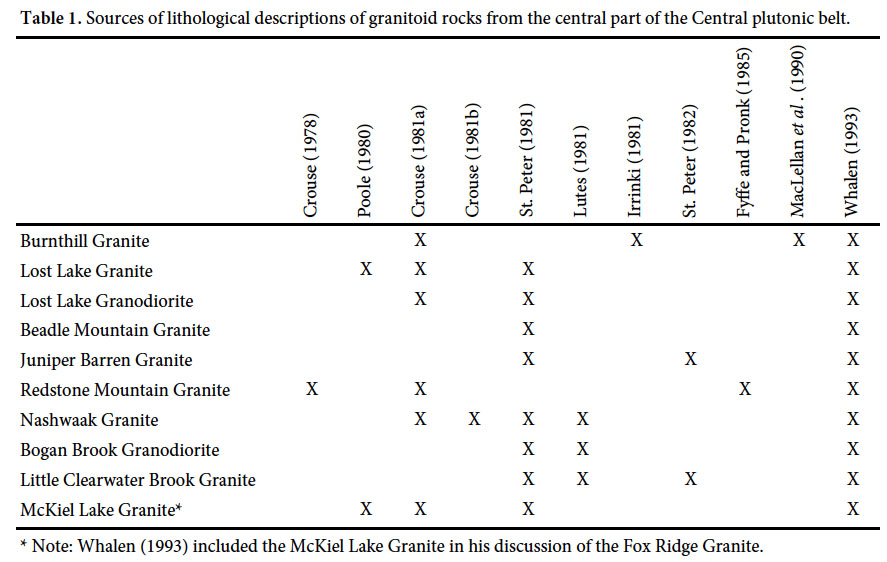 Display large image of Table 1* Note: Whalen (1993) included the McKiel Lake Granite in his discussion of the Fox Ridge Granite.
Display large image of Table 1* Note: Whalen (1993) included the McKiel Lake Granite in his discussion of the Fox Ridge Granite. 7 The Burnthill Granite is a texturally and mineralogically heterogeneous intrusion of coarse- to very coarse-grained biotite granite comprising a dominant phase of pink to red, medium- to coarse-grained, equigranular to seriate, alkali feldspar-phyric granite (Fig. 2a), and subsidiary phases of medium-grained equigranular granite, equigranular to quartz-feldspar-phyric microgranite, melanocratic biotite granite, and minor aplite and pegmatite (MacLellan et al. 1990). The Burnthill Granite intrudes Cambrian and Ordovician sedimentary and volcanic rocks of the Miramichi and Tetagouche groups, foliated granite (McKiel Lake Granite) and unfoliated granitoid rocks (Lost Lake Granite and Lost Lake Granodiorite). Tungsten mineralization at the Burnthill deposit (MacLellan et al. 1990) is genetically related to a buried cupola near the southeastern margin of the granite (Fig. 1).
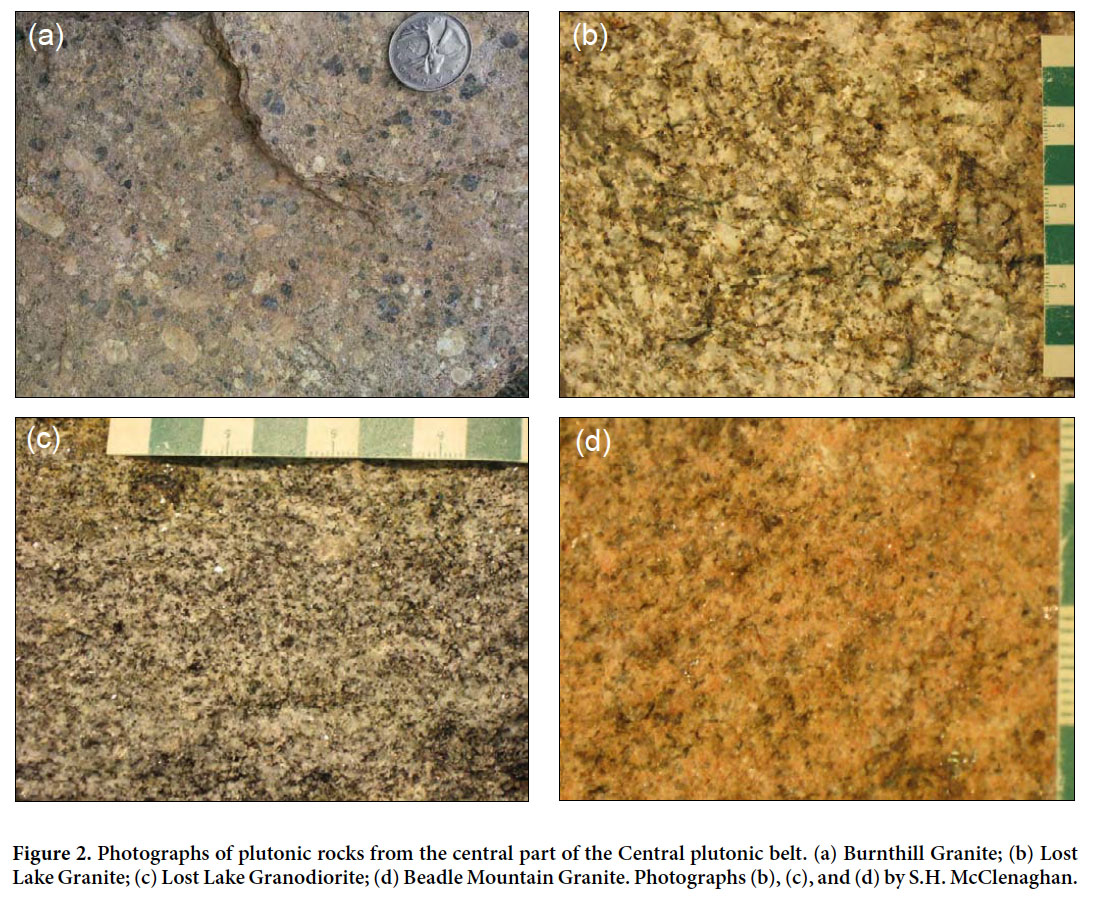 Display large image of Figure 2
Display large image of Figure 2
8 The Lost Lake Granite comprises light grey to light pink, medium- to coarse-grained, equigranular, biotite ± muscovite granite (Fig. 2b) and minor muscovite granite and pegmatite that commonly contain garnet, tourmaline, or beryl. It intrudes the foliated McKiel Lake Granite and high-grade metamorphic rocks (mainly paragneiss) of the Trousers Lake Metamorphic Suite, and is intruded by the Burnthill Granite.
9 The Lost Lake Granodiorite lies along the northern margin of the Lost Lake Granite (Fig. 1) and is interpreted as a cogenetic phase of the latter. It consists of grey to pink, fine- to medium-grained, equigranular biotite granite to granodiorite (Fig. 2c), and subordinate muscovite-biotite granite and muscovite pegmatite. It intrudes the McKiel Lake Granite and is intruded by the Burnthill Granite.
10 The Beadle Mountain Granite comprises light pink, medium- to coarse-grained, equigranular, muscovite, muscovite-biotite (Fig. 2d), and lesser biotite-muscovite granite, locally containing pods of muscovite-tourmaline pegmatite. The Beadle Mountain Granite has been interpreted to intrude the Juniper Barren Granite (St. Peter 1981), presumably as a younger, more evolved phase of that pluton, but for the most part it intrudes the Trousers Lake Metamorphic Suite near the eastern margin of the Juniper Barren Granite (Fig. 1).
11 The Juniper Barren Granite is composed of light grey to light pink, medium- to coarse-grained, equigranular to subporphyritic biotite granite (Fig. 3a), and minor biotite- and muscovite-bearing granite, garnetiferous aplite, and pegmatite. It intrudes the Trousers Lake Metamorphic Suite on the east and is in fault contact with Lower Devonian volcanic and sedimentary rocks of the Tobique Group on the north and west (Fig. 1).
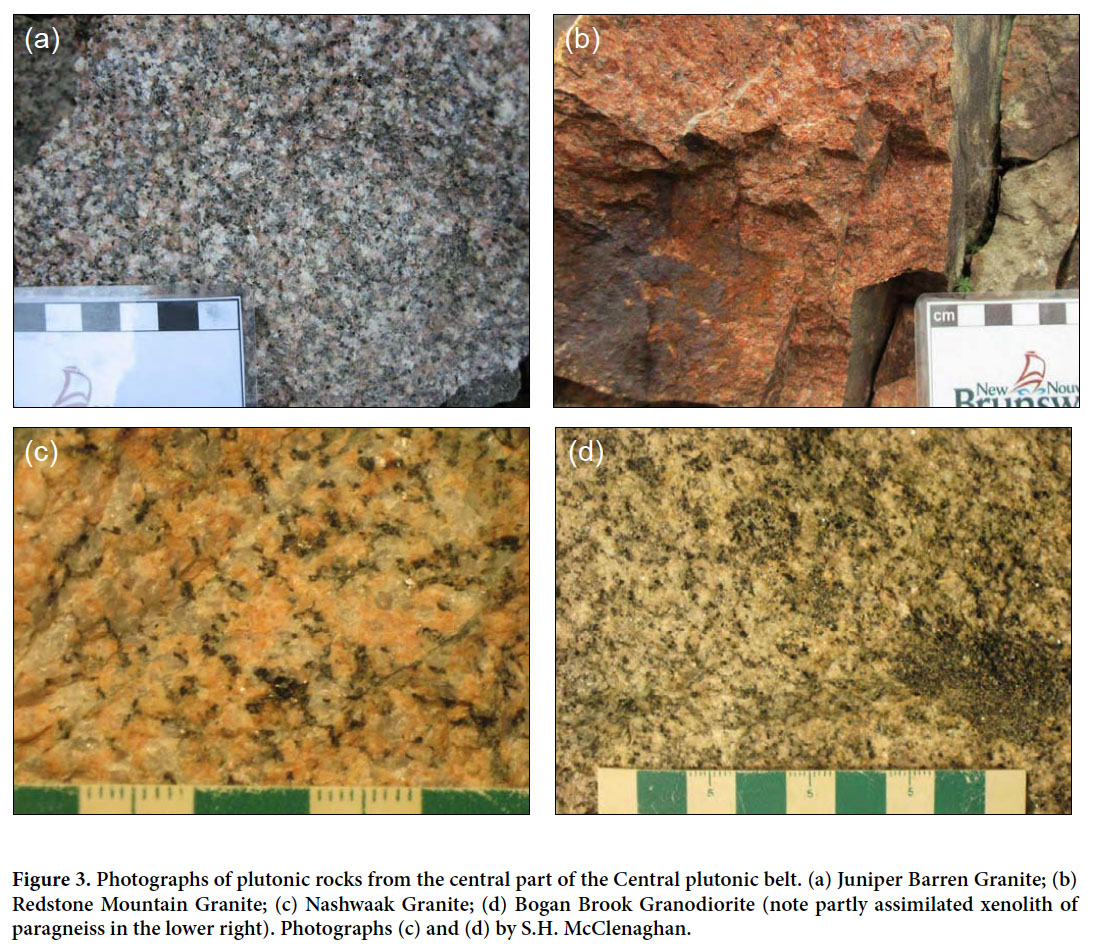 Display large image of Figure 3
Display large image of Figure 3
12 The Redstone Mountain Granite comprises at least two phases, including pink to red, medium-grained, equigranular to subporphyritic biotite-amphibole granite containing sparse quartz phenocrysts and white plagioclase phenocrysts set in a fine-grained granophyric groundmass (Fig. 3b), and buff to maroon, probably subvolcanic quartz-feldspar porphyry. Associated with the granite are a local aplitic phase, porphyritic felsic dykes, and dykes and plugs of fine- to medium-grained, pyroxene-amphibole diabase and gabbro. The Redstone Mountain Granite intrudes the Trousers Lake Metamorphic Suite and the Clearwater Brook Gabbro on the east, and late Silurian to Early Devonian volcanic rocks of the Tobique Group (Costigan Mountain Formation) on the west (Fig. 1).
13 The Nashwaak Granite consists of light grey to light pink, medium- to coarse-grained, equigranular to seriate, biotite and biotite-muscovite granite (Fig. 3c) that locally contains xenoliths of paragneiss, and minor garnetiferous, muscovite-bearing granite. It intrudes the Trousers Lake Metamorphic Suite, Miramichi Group and McKiel Lake Granite on the north, the Miramichi and Tetagouche groups and Howard Peak Granodiorite on the southeast, and the Becaguimec Lake Gabbro on the southwest (Fig. 1). The Sisson W-Mo deposit is located near the eastern margin of the Nashwaak Granite just south of the study area (Fig. 1).
14 The Bogan Brook Granodiorite is a medium to dark grey, fine- to medium-grained, equigranular biotite or hornblende-biotite granodiorite displaying a weak fabric and containing numerous xenoliths and enclaves of paragneiss or migmatized paragneiss (Fig. 3d) from the Trousers Lake Metamorphic Suite. It intrudes the latter unit and the Little Clearwater Brook Granite on the southeast, and is intruded by the Juniper Barren Granite on the northwest (Fig. 1).
15 The Little Clearwater Brook Granite consists of pink, medium-grained, foliated, porphyritic granite containing alkali feldspar augen and local enclaves of Cambrian–Ordovician paragneiss (Fig. 4a). It intrudes the Trousers Lake Metamorphic Suite and is intruded by the Bogan Brook Granodiorite (Fig. 1).
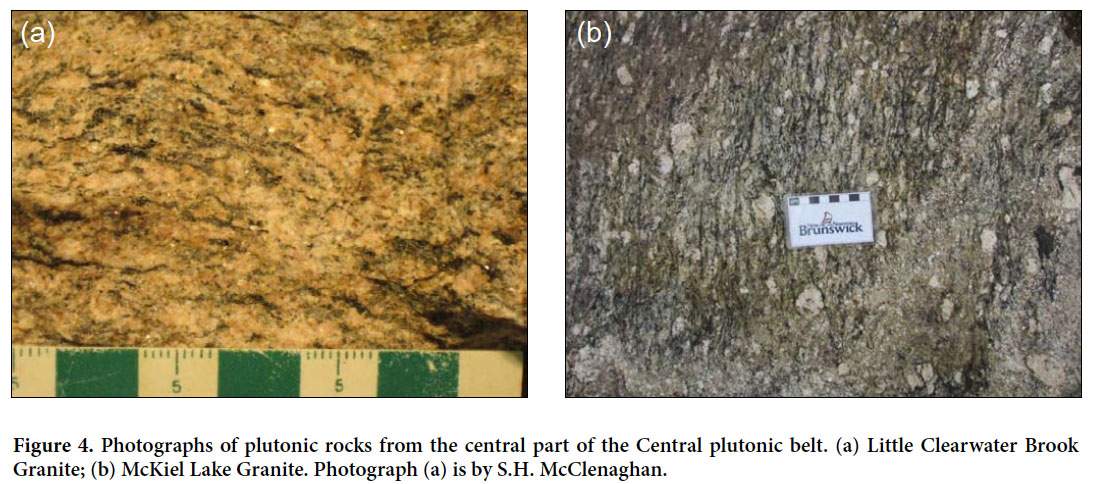 Display large image of Figure 4
Display large image of Figure 4
16 The McKiel Lake Granite comprises grey to pink, medium- to coarse-grained, strongly foliated, equigranular to megacrystic (feldspar-augen) biotite granite (Fig. 4b), minor fine- to medium-grained, equigranular, biotitemuscovite granite and granite metaporphyry, and pods and veins/dykes of pegmatite. It intrudes the Trousers Lake Metamorphic Suite and Miramichi Group and is intruded by the Nashwaak, Burnthill, and Lost Lake plutons (Fig. 1).
GEOCHRONOLOGY
17 Granite samples from eight plutons were analysed at the Jack Satterly Geochronology Laboratory, University of Toronto. Analytical methods are given in Appendix A; geochronological data are presented in Table 2 and plotted on concordia diagrams in Figures 5a–h. Geologically young zircon grains generally have less accumulated radiogenic Pb than older grains, so in three cases multi-grain analyses were performed rather than single zircon grain analyses to ensure sufficient signal to noise ratios; however, this increases the likelihood of analyzing older, pre-emplacement (inherited) zircon. Due to the greater abundance of 238U in geologically young zircon, and the greater uncertainty in the accuracy of the 235U decay constant (Schoene et al. 2006; Mattinson 2010), the average 206Pb/238U age is considered the most reliable age interpretation in most of these samples. In this study, the best age estimates for the granites are based on the weighted average 206Pb/238U dates, with the exception of the last three reported samples. In the latter cases (12-SHM-93, -94, -33), it is interpreted that Pb loss has resulted in discordance in some analyses, in which case both the oldest single 206Pb/238U date and the weighted average 207Pb/206Pb age are given as minimum and maximum age estimates, respectively.
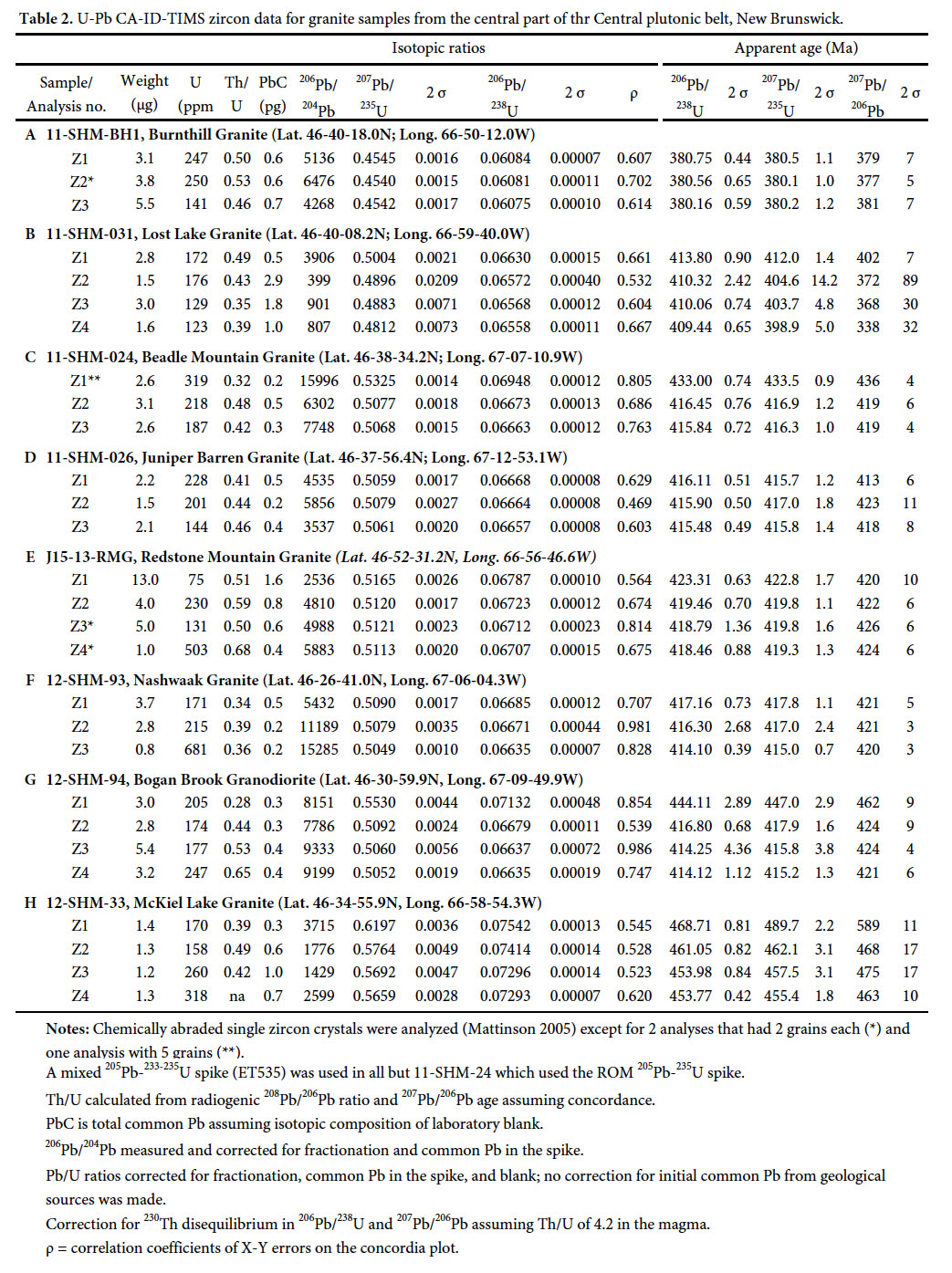 Display large image of Table 2Notes: Chemically abraded single zircon crystals were analyzed (Mattinson 2005) except for 2 analyses that had 2 grains each (*) and one analysis with 5 grains (**).A mixed 205Pb-233-235U spike (ET535) was used in all but 11-SHM-24 which used the ROM 205Pb-235U spike.Th/U calculated from radiogenic 208Pb/206Pb ratio and 207Pb/206Pb age assuming concordance.PbC is total common Pb assuming isotopic composition of laboratory blank.206Pb/204Pb measured and corrected for fractionation and common Pb in the spike.Pb/U ratios corrected for fractionation, common Pb in the spike, and blank; no correction for initial common Pb from geological sources was made.Correction for 230Th disequilibrium in 206Pb/238U and 207Pb/206Pb assuming Th/U of 4.2 in the magma.ρ = correlation coefficients of X-Y errors on the concordia plot.
Display large image of Table 2Notes: Chemically abraded single zircon crystals were analyzed (Mattinson 2005) except for 2 analyses that had 2 grains each (*) and one analysis with 5 grains (**).A mixed 205Pb-233-235U spike (ET535) was used in all but 11-SHM-24 which used the ROM 205Pb-235U spike.Th/U calculated from radiogenic 208Pb/206Pb ratio and 207Pb/206Pb age assuming concordance.PbC is total common Pb assuming isotopic composition of laboratory blank.206Pb/204Pb measured and corrected for fractionation and common Pb in the spike.Pb/U ratios corrected for fractionation, common Pb in the spike, and blank; no correction for initial common Pb from geological sources was made.Correction for 230Th disequilibrium in 206Pb/238U and 207Pb/206Pb assuming Th/U of 4.2 in the magma.ρ = correlation coefficients of X-Y errors on the concordia plot. 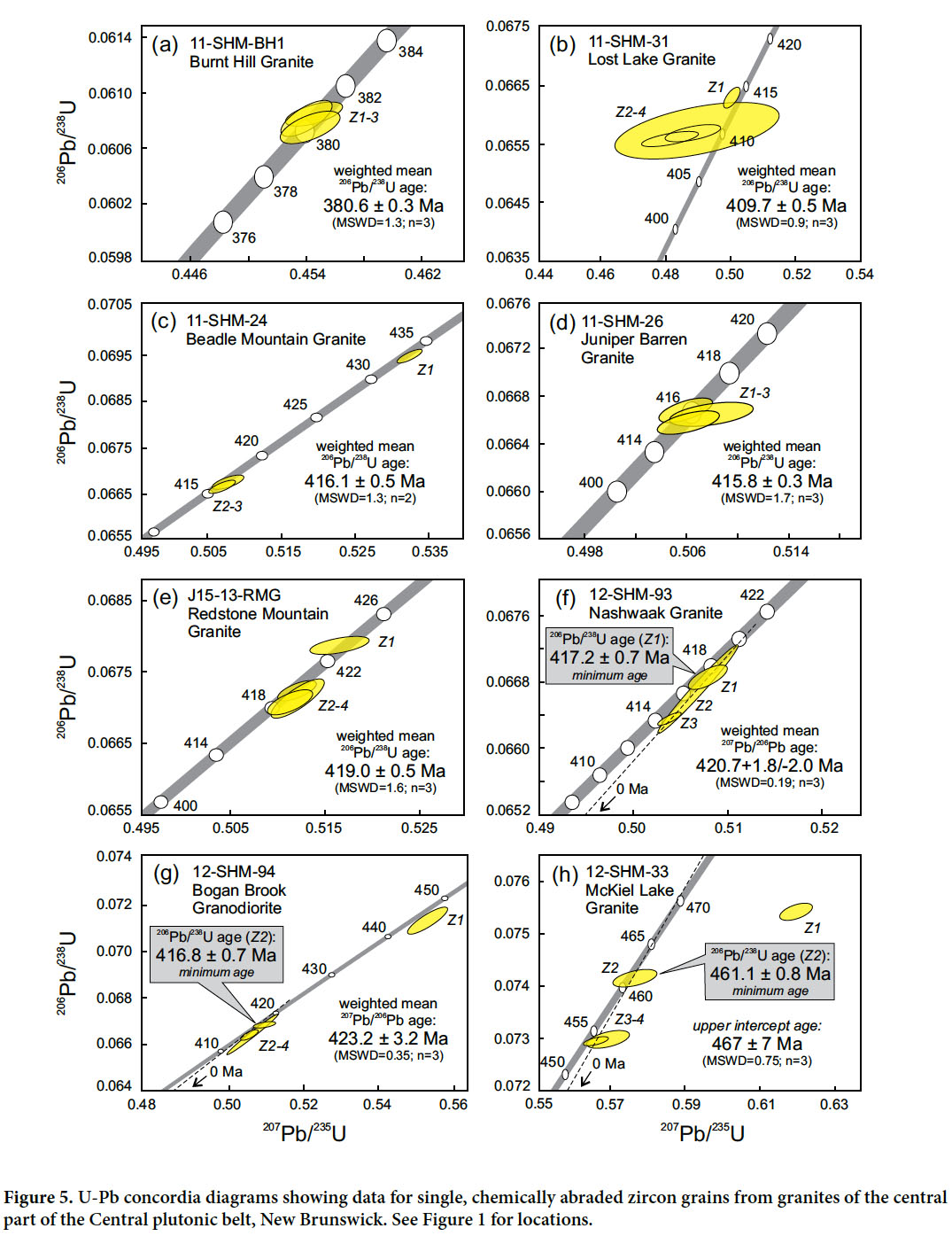 Display large image of Figure 5
Display large image of Figure 5
18 11-SHM-BH1: Burnthill Granite. Long, prismatic, euhedral crystals generally devoid of inclusions and cracks were analyzed. Two single grains and one fraction of two prismatic euhedral fragments (Z1–Z3) gave overlapping, concordant data with a weighted mean 206Pb/238U age of 380.6 ± 0.3 Ma (MSWD = 1.3; Fig. 5a), which is interpreted as the best estimate for the time of granite emplacement and crystallization.
19 11-SHM-31: Lost Lake Granite. Three of four single zircon grains (Z2–Z4) selected from an abundant population of clear, gem quality grains gave equivalent 206Pb/238U ages with a weighted mean of 409.7 ± 0.5 Ma (MSWD = 0.9; Fig. 5b). This age is interpreted as the time of granite emplacement and crystallization. A fourth grain (Z1) is slightly older at 413.8 ± 0.9 Ma and is interpreted as xenocrystic, or it may contain an inherited core component, and was therefore excluded from the mean.
20 11-SHM-24: Beadle Mountain Granite. Elongate to equant, euhedral zircon crystals were selected for chemical abrasion. Two single grains (Z2 and Z3) gave concordant and overlapping data that have a weighted mean 206Pb/238U age of 416.1 ± 0.5 Ma (MSWD = 1.3; Fig. 5c). Five small crystals (Z1) gave concordant data with an older 206Pb/238U age of 433.0 ± 0.7 Ma, which was likely a mixture of magmatic grains and one or more inherited grains, and is therefore not considered geologically meaningful. The 416.1 ± 0.5 Ma age is considered the best age estimate for granite crystallization.
21 11-SHM-26: Juniper Barren Granite. Abundant, euhedral, elongate to equant zircon grains are largely unaltered, and a group of the clearest grains was selected for chemical abrasion. Three single zircon grains (Z1–Z3) gave concordant, overlapping data that have a weighted mean 206Pb/238U age of 415.8 ± 0.3 Ma (MSWD = 1.7; Fig. 5d). This is interpreted as the best estimate for the time of emplacement and crystallization of the granite, and is within error of the 416.1 ± 0.5 Ma age for the Beadle Mountain Granite.
22 J15-13-RMG: Redstone Mountain Granite. Zircon crystals from this granite are typically fresh, euhedral stubby prisms. Three analyses (one single grain and two analyses of two grains each) gave concordant, overlapping data with a weighted mean 206Pb/238U age of 419.0 ± 0.5 Ma (MSWD = 1.6; Fig. 5e), and this age is interpreted to best estimate the time of granite crystallization. One grain (Z1), larger and older than the other dated grains, is interpreted as a xenocryst and has a 206Pb/238U age of 423.3 ± 0.6 Ma.
23 12-SHM-93: Nashwaak Granite. Three elongate, euhedral zircon crystals selected for chemical abrasion gave overlapping data (Z1–Z3) that are 0.9% to 2.7% discordant and have consistent 207Pb/206Pb ages. A line through all of the data indicates intercept ages of 423 ± 16 Ma and 134 ± 640 Ma (MSWD = 0.21) when unconstrained, but is imprecise due to the lack of spread in the data. If time-averaged Pb loss at 200 Ma is assumed, an upper intercept age of 425.1 ± 3.5 Ma (MSWD = 0.15) is given. The youngest possible age interpretation is given by the oldest 206Pb/238U age for Z1 at 417.2 ± 0.7 Ma, but if any Pb loss has occurred this age would be too young. A line calculation anchored at 0 Ma (which is the same as taking the mean 207Pb/206Pb age) gives an upper intercept age of 420.7 +1.8/-2.0 Ma (MSWD = 0.19; Fig. 5f), which takes into account all of the data and incorporates the possibility of recent minor Pb loss, and is interpreted to represent a minimum age that approximates the time of granite emplacement.
24 12-SHM-94: Bogan Brook Granodiorite. Three single stubby to elongate euhedral prismatic zircon crystals (Z2–Z4) give overlapping discordant data (1.7–2.7%) that have an upper intercept age of 423.2 ± 3.2 Ma when constrained through 0 Ma (i.e., the mean 207Pb/206Pb age) (Fig. 5g). The slight discordance of the data leaves the age interpretation open to the possibility of early Pb loss. A line anchored at 200 Ma, for example, increases the upper intercept age to 430 ± 6 Ma (MSWD = 0.29), which is within error of the mean 207Pb/206Pb age. The 423.2 ± 3.2 Ma age is interpreted as a close estimate for the time of granite emplacement, but should be considered a minimum age estimate. A fourth grain (Z1) is older and discordant (462 ± 9 Ma, 3.9% discordant) and apparently inherited from an older crustal source.
25 12-SHM-33: McKiel Lake Granite. U-Pb data for three single, euhedral, stubby to elongate, prismatic zircon crystals, can be interpreted to indicate a maximum age of 467 ± 7 Ma (Fig. 5h), based on a Pb loss line anchored at 0 Ma and using concordant datum Z2, which has a 207Pb/206Pb age of 468 ± 17 Ma (1.4% discordant), and two younger, overlapping and discordant data (Z3–Z4) that plot just to the right of the curve. The 467 ± 7 Ma age is considered the best approximation for the time of granite crystallization, implying emplacement in the Middle Ordovician, although an Early Ordovician age cannot be ruled out.
Discussion of geochronological data
26 U-Pb (zircon) age determinations confirm that granites from the central part of the Central plutonic belt were emplaced at three widely spaced time intervals, namely Early to Middle Ordovician (467 ± 7 Ma) for foliated granite, late Silurian to Early Devonian (423 to 409 Ma) for most of the unfoliated granites, and Late Devonian (380 Ma) for the post-orogenic Burnthill Granite. The McKiel Lake Granite is similar in age to other Ordovician granites in the Miramichi inlier/Central plutonic belt (McNicoll et al. 2003). Aside from the Bogan Brook Granodiorite, the Nashwaak Granite is the oldest Silurian–Devonian pluton yet dated in the belt; however, if no Pb loss has occurred, the age may be similar to that of the Juniper Barren Granite a few km to the northwest (Fig. 1). Furthermore, the granite has been shown to consist of more than one phase (Lutes 1981), so it is possible that undated parts of the granites may be younger. The ages of the Juniper Barren and Beadle Mountain granites overlap within error, and are very close to the ages of large batholiths north of the study area, namely the North Pole Stream Granite (417 ± 1 Ma) and Mount Elizabeth Granite (417 ± 2 Ma) (Bevier and Whalen 1990). In view of their close proximity and several geochemical indicators (see below), it seems clear that the Beadle Mountain Granite is a more evolved phase of the Juniper Barren Granite. St. Peter (1981) reported veins of muscovite granite cutting the Juniper Barren Granite; hence, despite the interpreted crystallization age suggesting that it is slightly older, the Beadle Mountain Granite is probably slightly younger. The Redstone Mountain Granite is intermediate in age between the Nashwaak and Juniper Barren/Beadle Mountain intrusions, but is geochemically distinct and interpreted to be tectonomagmatically unrelated to the other Silurian–Devonian granites, as discussed below. The Lost Lake Granite is the youngest of the Early Devonian plutonic family, and a hiatus of almost 30 myr separates it from the highly evolved and metal-specialized Burnthill Granite.
27 Newly acquired U-Pb (zircon) data have been compiled in chart form along with previously published Rb-Sr, K-Ar or 40Ar/39Ar mineral or whole-rock ages to facilitate easy comparisons (Fig. 6). It is immediately clear from the chart that several of the U-Pb (zircon) crystallization ages are very close to the mineral ages. For example, five 40Ar/39Ar (biotite and muscovite) plateau and total gas ages reported for the Burnthill Granite range from 377 to 386 Ma (Taylor et al. 1987), including three ages (380 Ma–biotite total gas, 378 ± 3 Ma–biotite plateau; and 379 ± 4 Ma–muscovite total gas) that closely match the U-Pb emplacement age of 380.6 ± 0.3 Ma, as well as the inferred crystallization age of 381 Ma proposed by MacLellan et al. (1990). Similarly, Rb-Sr whole-rock isochron ages of 412 ± 12 Ma and 411 ± 13 Ma (Poole 1980), and K-Ar (muscovite) and K-Ar (biotite) ages of 408 ± 7 Ma and 402 ± 4 Ma, respectively (Whalen and Theriault 1990) compare well with the 409.7 ± 0.5 Ma crystallization age of the Lost Lake Granite. Slightly younger K-Ar muscovite and biotite ages of 402 ± 5 Ma and 398 ± 4 Ma, respectively, were reported for the Lost Lake Granodiorite. The 420.7 +1.8/-2.0 Ma TIMS age of the Nashwaak Granite overlaps the Rb-Sr (muscovite) age of 422 ± 4 Ma reported by Whalen and Theriault (1990), although their K-Ar (muscovite) age of 396 ± 5 Ma from the same location is difficult to explain. The Bogan Brook Granodiorite has yielded a K-Ar (muscovite) age of 421 ± 6 Ma (Bevier and Whalen 1990), overlapping the TIMS age of 423.2 ± 3.2 Ma. The reported Rb-Sr (muscovite) age of 433 ± 4 Ma (Bevier and Whalen 1990) was interpreted as being closer to the age of emplacement, and the younger K-Ar (muscovite) age to reflect a long cooling history, but the older age clearly requires a different explanation, probably involving lack of closure of the system with respect to Rb and Sr. (It should be noted that Whalen and Theriault (1990) and Bevier and Whalen (1990) incorrectly identify the sampled pluton as Juniper Barren Granite, which is adjacent to the Bogan Brook Granodiorite). Finally, Poole (1980) reported a Rb-Sr whole-rock isochron of 498 ± 19 Ma for five of eight whole rock samples, and an errorchron of 484 ± 33 Ma for eight samples of his “Sugar granite”. Again, mineral ages exceeding the 467 ± 7 Ma crystallization age of the granite may be explained by mobility of Rb and/or Sr in a non-closed system, although evidence presented below argues for minimal post-emplacement alteration in all granites. In contrast, mineral ages that closely match emplacement ages can be attributed to the absence of post-cooling thermal perturbation. The range of 40Ar/39Ar ages for the Burnthill Granite (Taylor et al. 1987) suggests that different parts or phases of the pluton cooled at different rates.
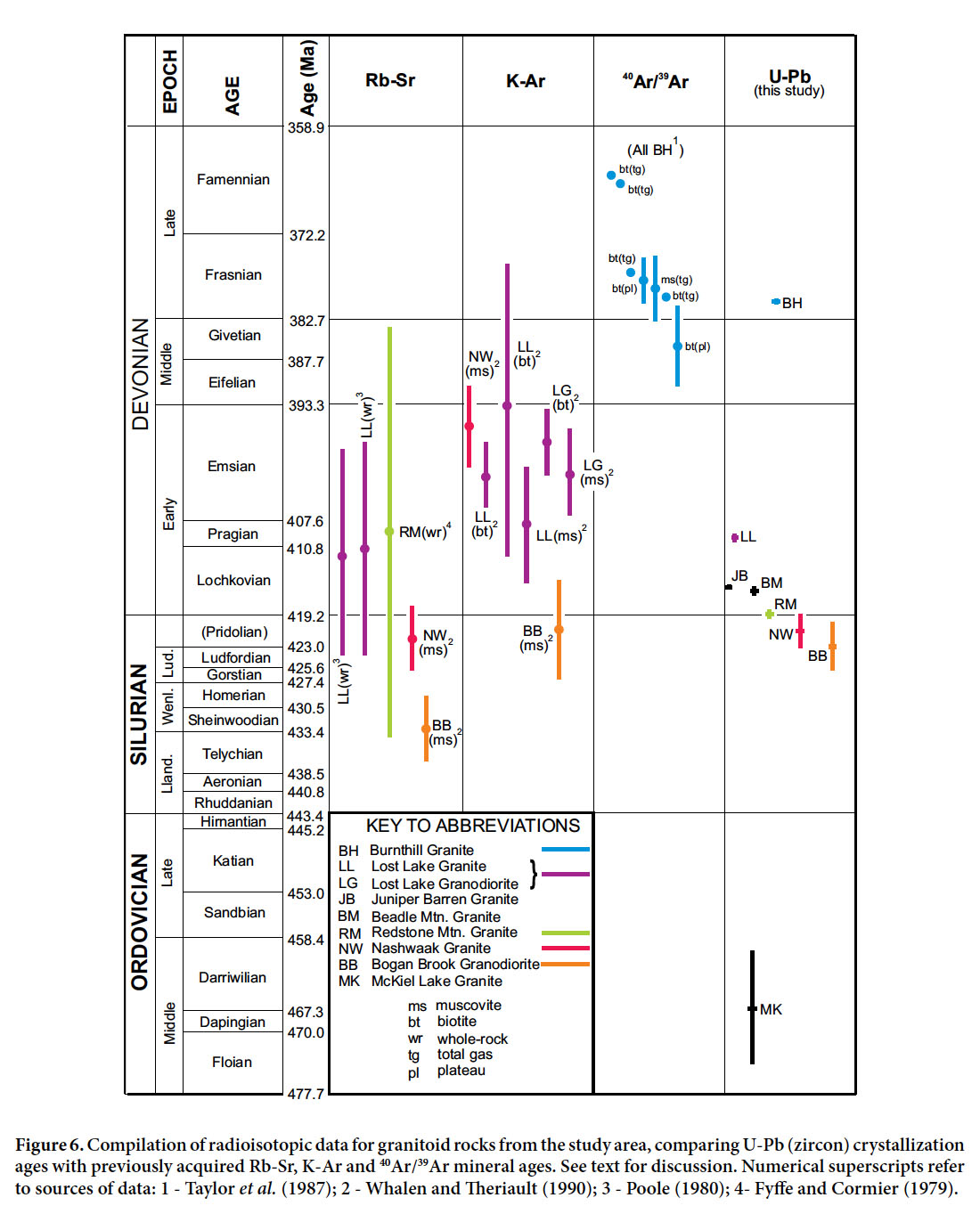 Display large image of Figure 6
Display large image of Figure 6
LITHOGEOCHEMISTRY
28 A total of 68 samples from ten plutons were analyzed in this study. Analytical methods are summarized in Appendix A, and the complete dataset is presented in Appendix B. Average compositions for individual plutons are given in Table 3; these averages were determined by supplementing newly acquired analyses (i.e., the data in Appendix B) with data compiled from Whalen (1993; 23 samples from 8 plutons) and MacLellan et al. (1990; 33 samples from the Burnthill pluton) (see Appendix A for comments on their analytical methods). Similarly, the geochemical variation and discrimination diagrams (Figs. 7–22) incorporate data from those two sources. Newly acquired analyses of granites from the study area reveal geochemical characteristics very similar to those reported by Whalen (1993); furthermore, in most cases, felsic plutonic rocks of all ages display overall geochemical similarity. Post-emplacement alteration and alkali mobility has been relatively minor based on the (K2O + Na2O) vs. K2O/(K2O + Na2O) diagram of Hughes (1973) (not shown), as almost 90% of samples plot within the “igneous spectrum” and most of the others are only marginally altered using this criterion. Nevertheless, these slightly altered samples were not included in the geochemical plots discussed herein. Average Mg#s (= 100 x mol. MgO/(mol. MgO + FeOt) for Silurian–Devonian granite plutons range from 18.1 to 34.3 (Table 3); the most evolved granites according to this measure are the Redstone Mountain (Mg# = 18.1), Beadle Mountain (23.0) and Burnthill (24.8) plutons.
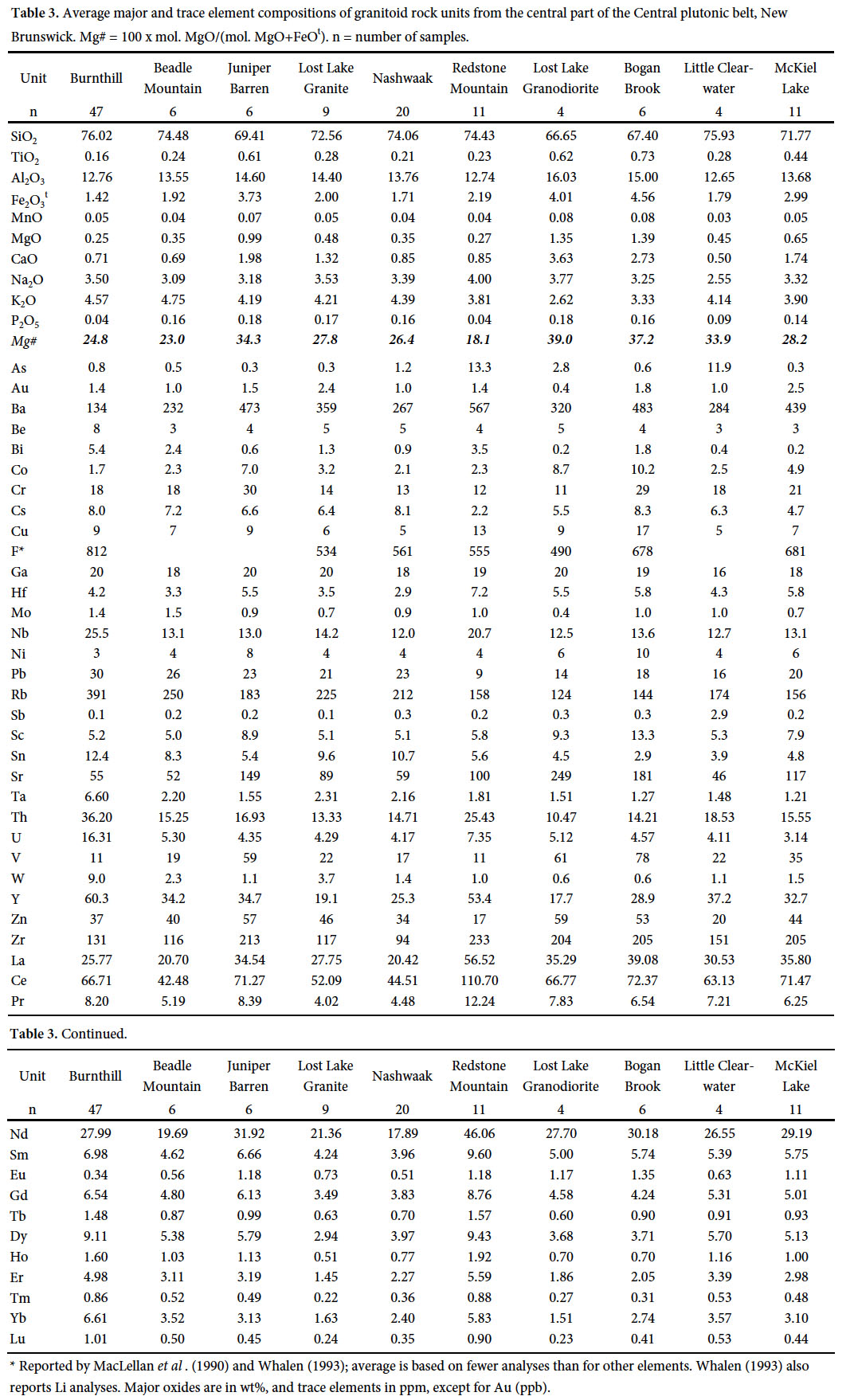 Display large image of Table 3* Reported by MacLellan et al. (1990) and Whalen (1993); average is based on fewer analyses than for other elements. Whalen (1993) also reports Li analyses. Major oxides are in wt%, and trace elements in ppm, except for Au (ppb).
Display large image of Table 3* Reported by MacLellan et al. (1990) and Whalen (1993); average is based on fewer analyses than for other elements. Whalen (1993) also reports Li analyses. Major oxides are in wt%, and trace elements in ppm, except for Au (ppb). 29 Most samples from all plutons are peraluminous according to the aluminum saturation index (ASI) of Shand (1943) (modified by Frost et al. 2001; Fig. 7), although there is some overlap into the metaluminous field. Most plutons are classified as S-type using ASI = 1.1 as the boundary between I- and S-type granites (Chappell and White 1992; Fig. 7). However, the Burnthill Granite shows significant overlap onto the I-type field (Fig. 7) and was interpreted as such (as were Ganderian granites as a whole) by Whalen (1993). Samples from most plutons fall in the fields of both ferroan and magnesian granites on the Fe *(= FeO t/(FeO t+ MgO)) vs. SiO2 diagram of Frost et al. (2001; Fig. 8). Exceptions are the Redstone Mountain Granite, which plots entirely within the ferroan field (Fig. 8b), and the closely related Juniper Barren and Beadle Mountain plutons (Fig. 8c)−the dominantly muscovite-bearing Beadle Mountain Granite falls mainly in the ferroan field, whereas the dominantly biotite-bearing Juniper Barren Granite falls mainly in the magnesian field. The modified alkali-lime index (MALI = (Na2O + K2O–CaO)) of Frost et al. (2001) demonstrates that most samples from all plutons are calc-alkalic, with minor overlap onto the adjacent alkali-calcic and calcic fields (Fig. 9). The normative mineralogy-based Q-ANOR diagram of Streckeisen and LeMaitre (1979) shows that intrusive rock types in the granitic plutons include monzogranite, syenogranite, alkali-feldspar granite, and rare granodiorite (Fig. 10). On this diagram, empirically-derived compositional trends (Whalen and Frost 2013; Hildebrand and Whalen 2014) again illustrate a dominant calc-alkalic character.
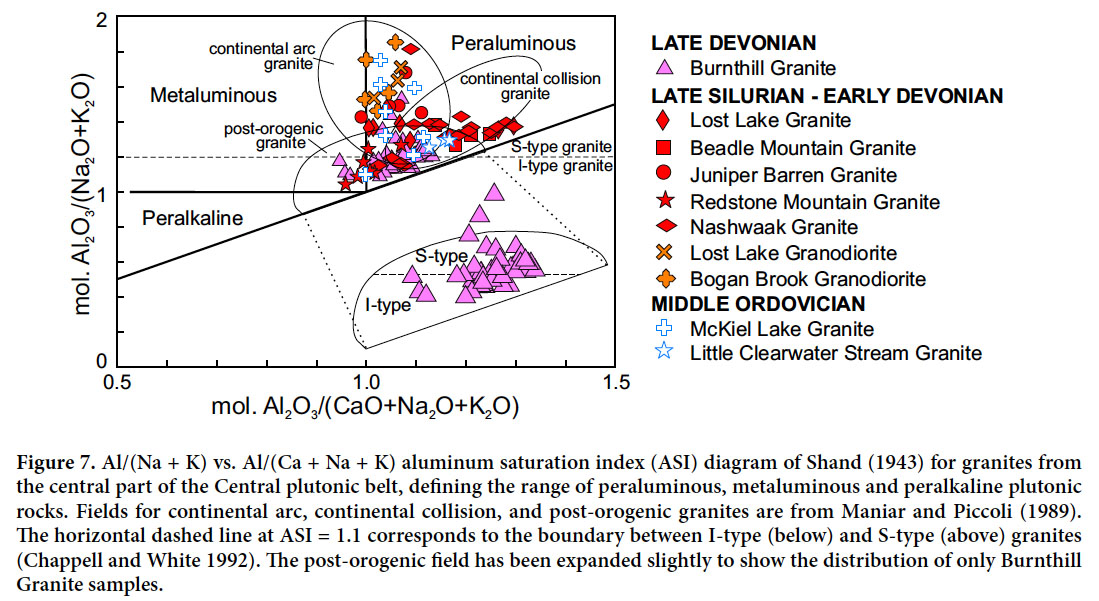 Display large image of Figure 7
Display large image of Figure 7
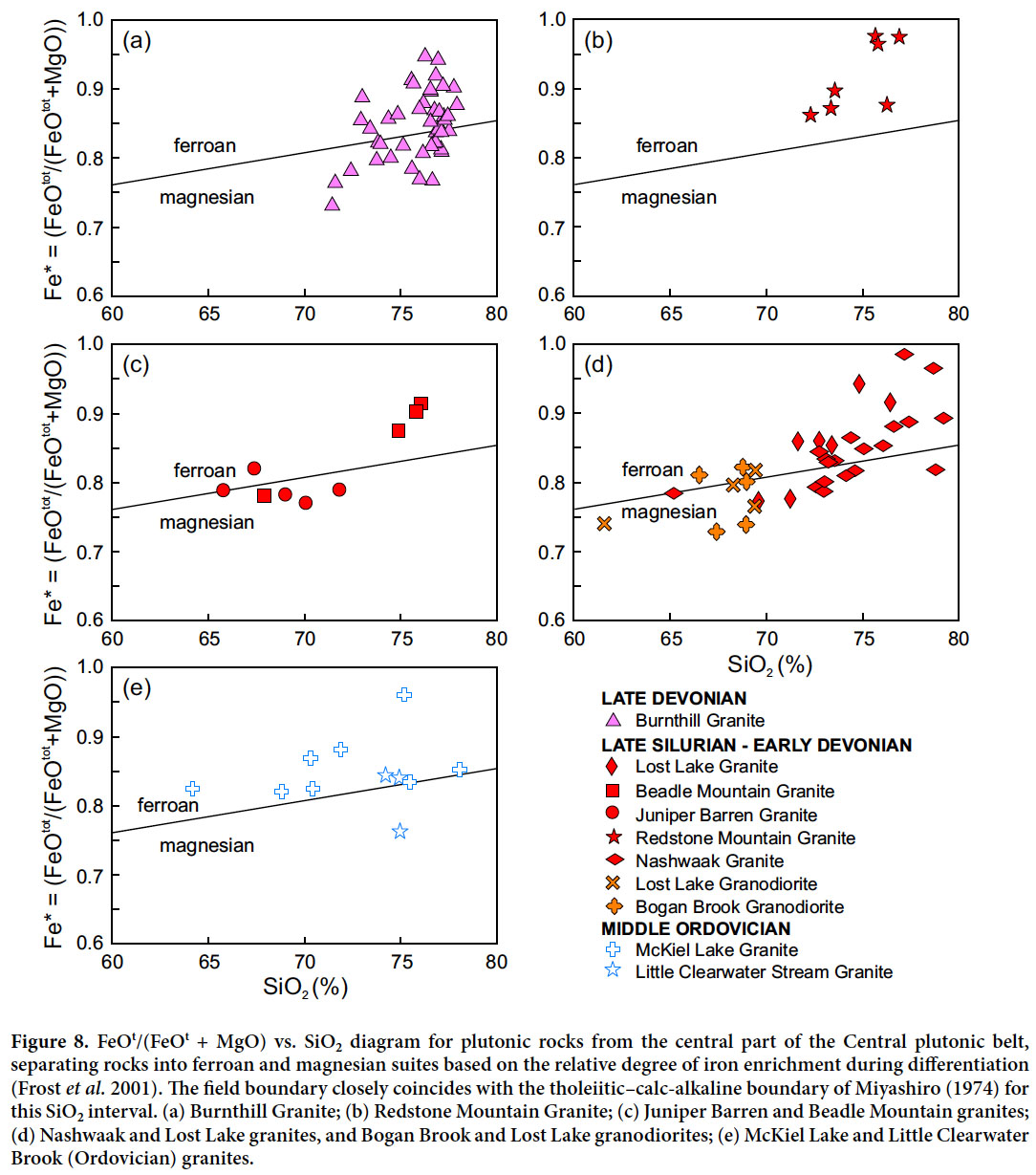 Display large image of Figure 8
Display large image of Figure 8
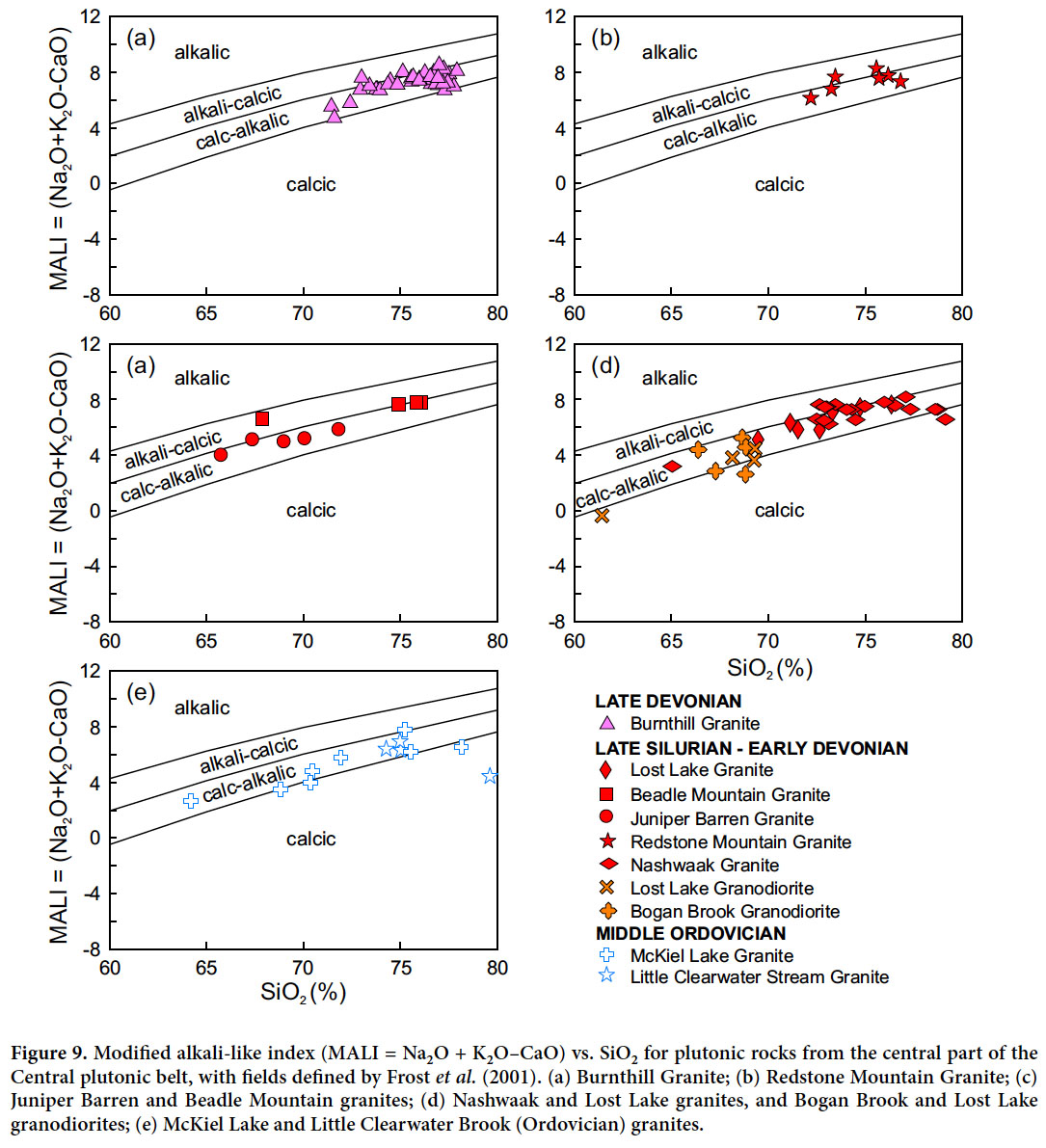 Display large image of Figure 9
Display large image of Figure 9
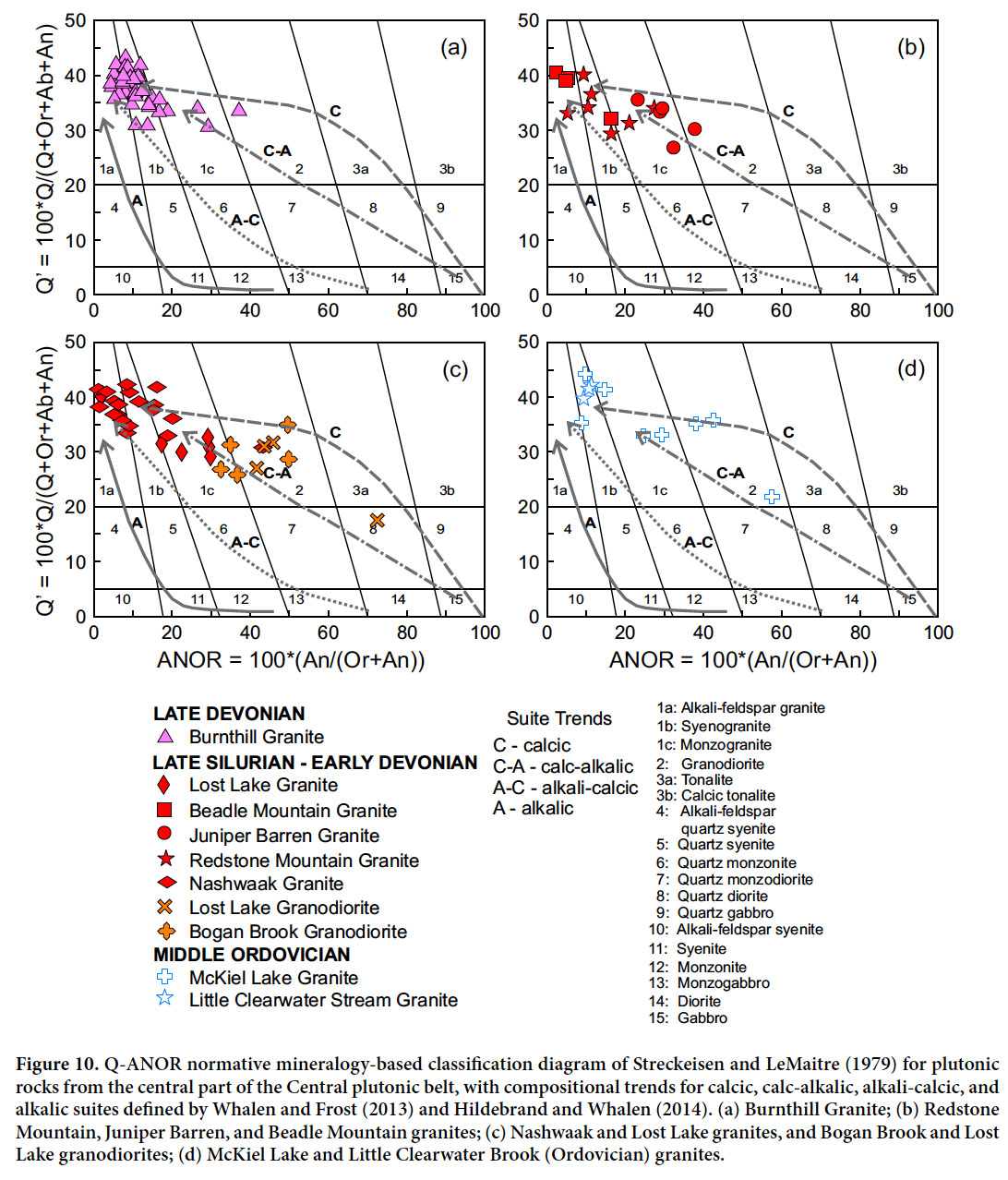 Display large image of Figure 10
Display large image of Figure 10
30 Trace-element variation diagrams highlight some of the similarities and differences among the various plutonic rock units. On a Sr vs. Rb plot (considered to represent primary abundances of these elements because of the aforementioned low degree of alkali-element mobility), the Burnthill Granite is notably enriched in Rb, whereas the Redstone Mountain Granite has generally lower concentrations compared to all other plutons, which cluster in the central part of the diagram (Fig. 11a). On a U vs. Th diagram, the Burnthill Granite forms a distinct population characterized by much higher abundances of both elements (Fig. 11b). The Redstone Mountain Granite, and the combined Juniper Barren and Beadle Mountain plutons, each form well-defined clusters, whereas the Nashwaak and Lost Lake plutons show a wide range of Th values. On an Y vs. TiO2 diagram, samples of Burnthill Granite define a dense cluster having a negative slope (Fig. 12a), resembling the distribution of Redstone Mountain samples (Fig. 12b). In contrast, other Silurian–Devonian granites (Fig. 12b), as well as the Ordovician granites (Fig. 12c), plot on a trend having a flat to slightly positive slope, reflecting a wide range of TiO2 over a comparatively restricted range of Y abundance. A TiO2 vs. Zr plot shows that most of the data from all plutons define a concave-upward curve having a moderate to steep positive slope (Figs. 13a–c), whereas the Redstone Mountain samples form a separate trend characterized by a slightly positive to flat slope (Fig. 13b). Rare-earth element (REE) profiles also illustrate the distinctiveness of the Burnthill and Redstone Mountain granites; the former (Fig. 14a) has a significantly flatter slope (La/Yb = 3.9) and more prominent negative Eu anomaly (Sm/Eu = 20.5) compared to all other plutons (Figs. 14b–d), in which La/Yb ranges from 5.9 to 23.4 and Sm/Eu from 4.3 to 8.6. The Redstone Mountain profile (Fig. 14b) has the same slope as other Silurian–Devonian granites, but it contains much higher absolute REE abundances (average ΣREE = 271 ppm) compared to the other units (average ΣREE = 106 to 175 ppm; Table 3). Aside from the Redstone Mountain pluton, profiles for Silurian–Devonian granites (Fig. 14b) and Ordovician granites (Fig. 14d) are essentially identical (see also Whalen 1993). The Lost Lake Granite and Lost Lake Granodiorite display the steepest slopes (La/Yb = 17.0 and 23.4, respectively) because of their slight depletion in heavy REE. The granodiorites (Fig. 14c) lack a significant Eu anomaly and have the lowest Sm/Eu (4.3).
 Display large image of Figure 11
Display large image of Figure 11
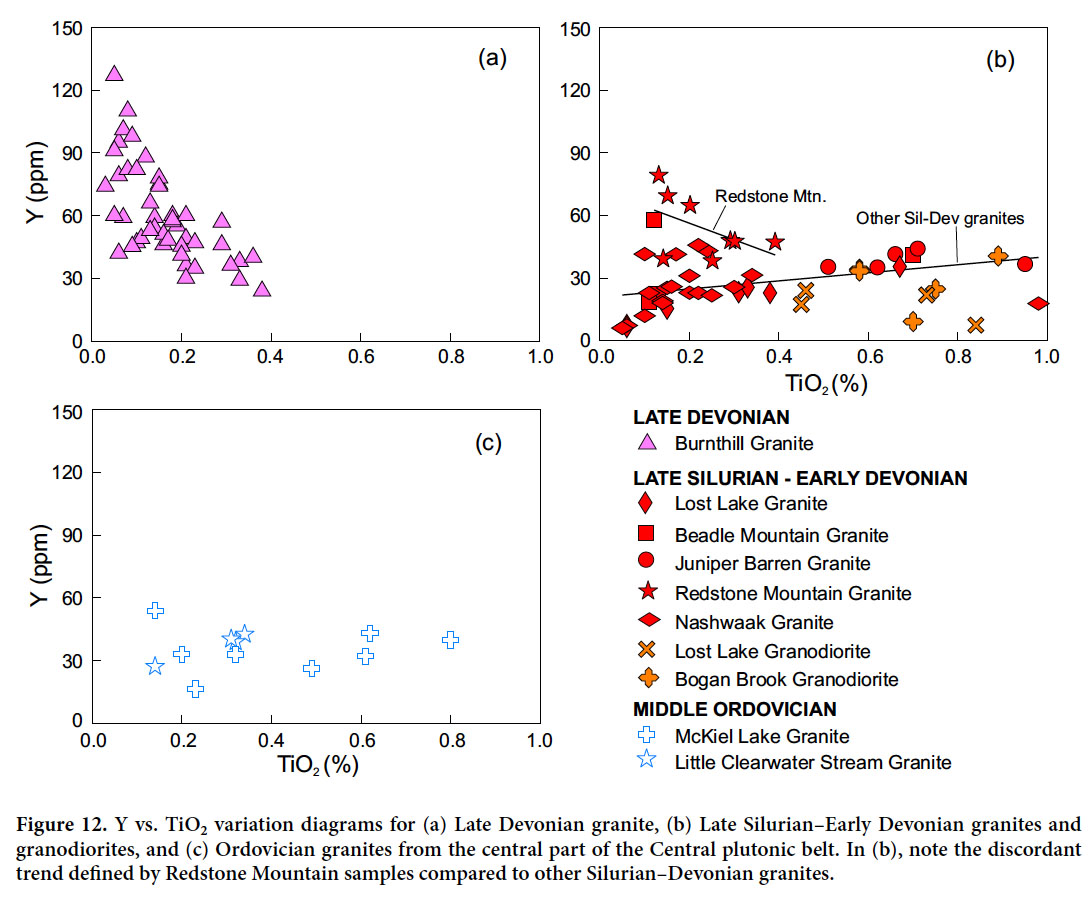 Display large image of Figure 12
Display large image of Figure 12
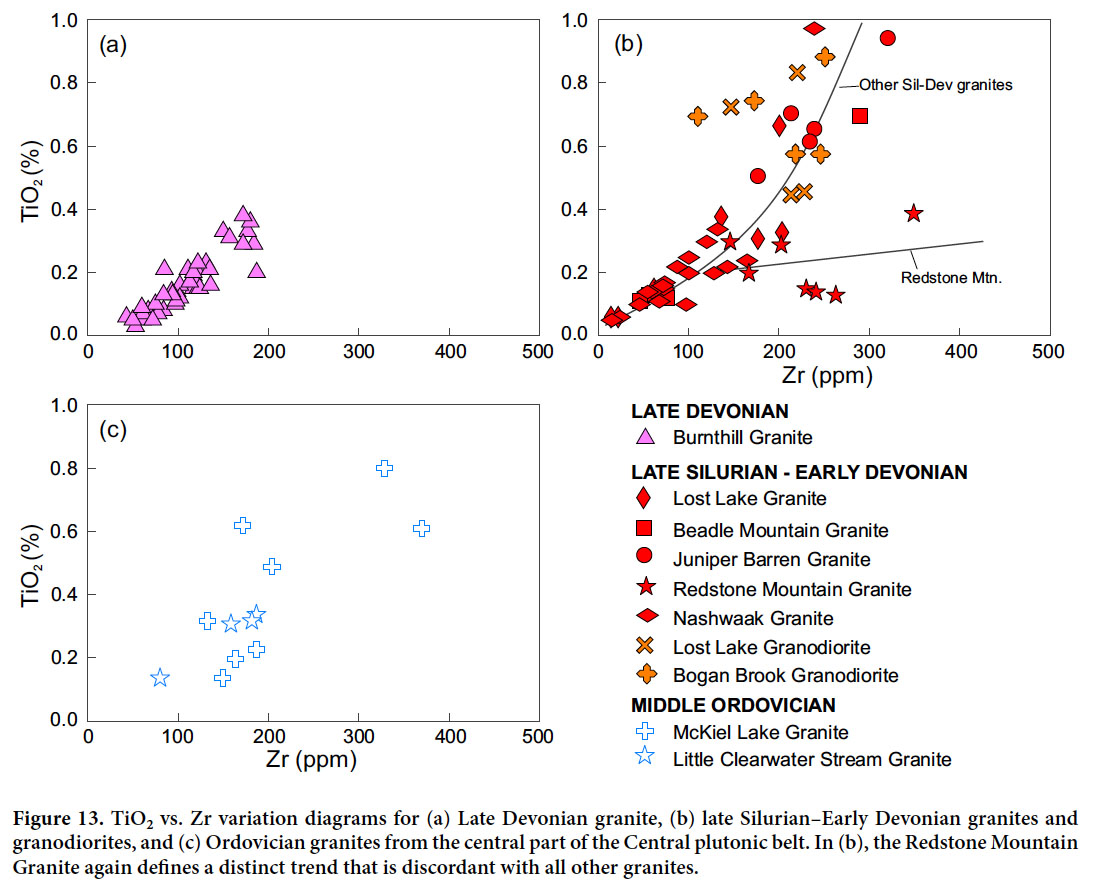 Display large image of Figure 13
Display large image of Figure 13
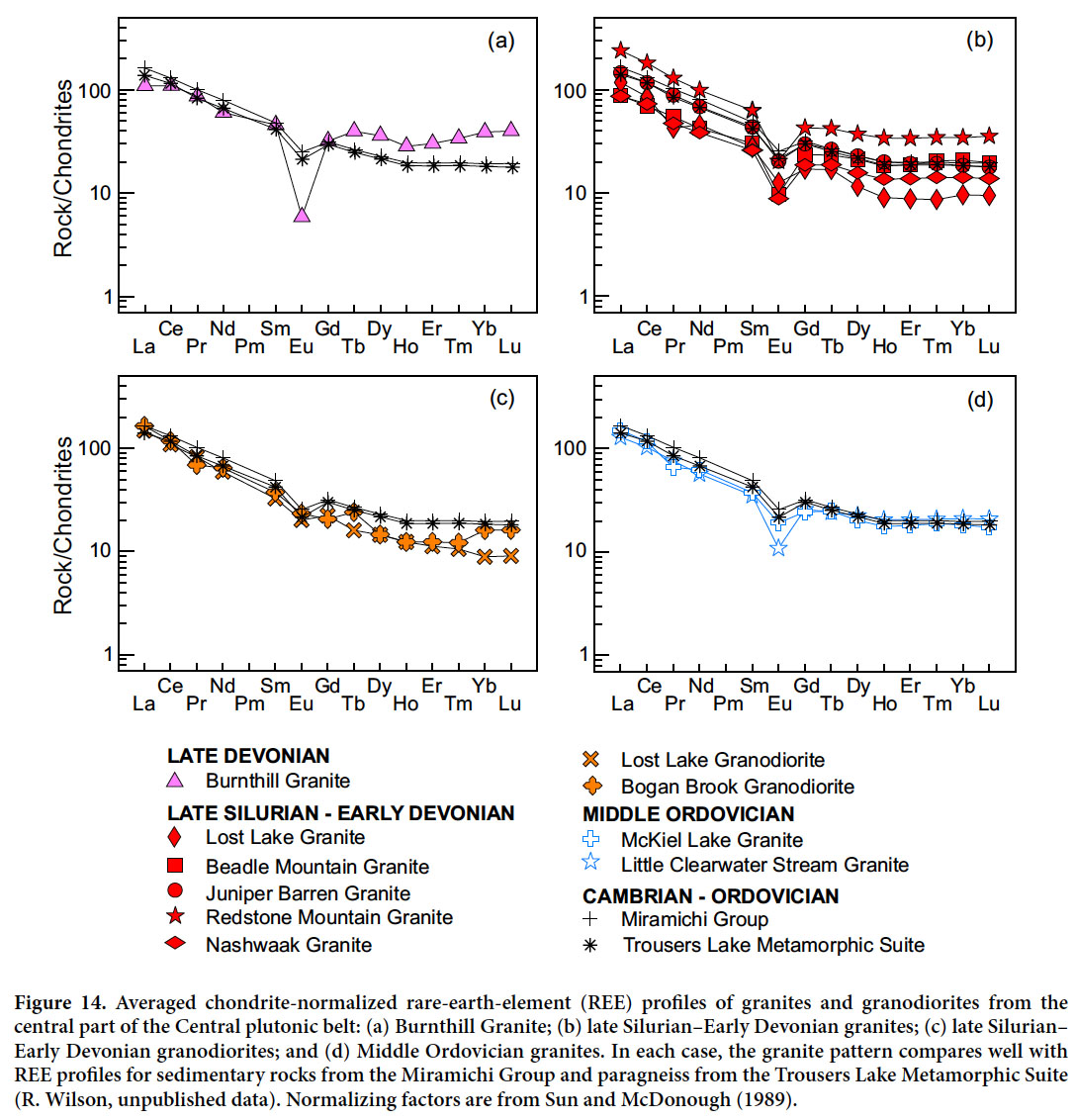 Display large image of Figure 14
Display large image of Figure 14
31 In the genetic/petrologic classification of Appalachian granites devised by Whalen (1993) and Currie (1995), all plutons in the study area, except for the Burnthill and Redstone Mountain granites, are grouped together as either deformed (“type 5a”: Ordovician) or massive (“type 7a”: Silurian–Devonian), chemically and isotopically indistinguishable peraluminous granites. The Redstone Mountain Granite was considered a “type 8”, composite pluton that forms a bimodal association with spatially and (presumably) genetically related mafic intrusive rocks, in this case the Clearwater Brook Gabbro (Fig. 1) and scattered mafic plugs and dykes. This bimodal association is consistent with the close spatial and genetic association with (and geochemical similarity to) bimodal volcanic rocks of the Costigan Mountain Formation (Tobique Group; Walker and Clark 2012). The Burnthill Granite was included in “type 9b” plutons, namely evolved, high-silica granites lacking mafic phases and exhibiting large degrees of crystal fractionation (Whalen 1993). It is clear that the new analytical data obtained on these plutons and the classification diagrams discussed in this section support the interpretations and conclusions of Whalen (1993) and Currie (1995).
TECTONIC CONTEXT: SOURCE AND SETTING
32 Most plutons display some degree of overlap between the volcanic arc and within-plate fields on the Rb vs. Nb + Y tectonic discrimination diagram (Pearce et al. 1984; Pearce 1996; Fig. 15). However, the Burnthill Granite (Fig. 15a) and especially the Redstone Mountain Granite (Fig. 15b) more closely resemble within-plate granites, whereas the Lost Lake, Nashwaak, and Bogan Brook plutons (Fig. 15d) dominantly resemble volcanic arc granites. Ordovician granites fall within or very close to the volcanic arc field (Fig. 15e), which is somewhat at odds with Whalen (1993) and Whalen et al. (1998), who reported that Ordovician granites in the Gander zone are within-plate types except for intrusions near Woodstock that are genetically related to arc volcanic rocks of the Meductic Group. Aside from the Burnthill pluton, most data points fall within the domain of post-collisional granites delineated by Pearce (1996). Similar overlap of data points between syn- and post-collision and volcanic arc fields is noted on the Hf-Rb-Ta ternary diagram of Harris et al. (1986) (Fig. 16), and on the major element-based Shand index with fields defined by Maniar and Piccoli (1989) (Fig. 7). However, on both of these diagrams, the Burnthill Granite plots almost exclusively within the syn- or post-collisional fields.
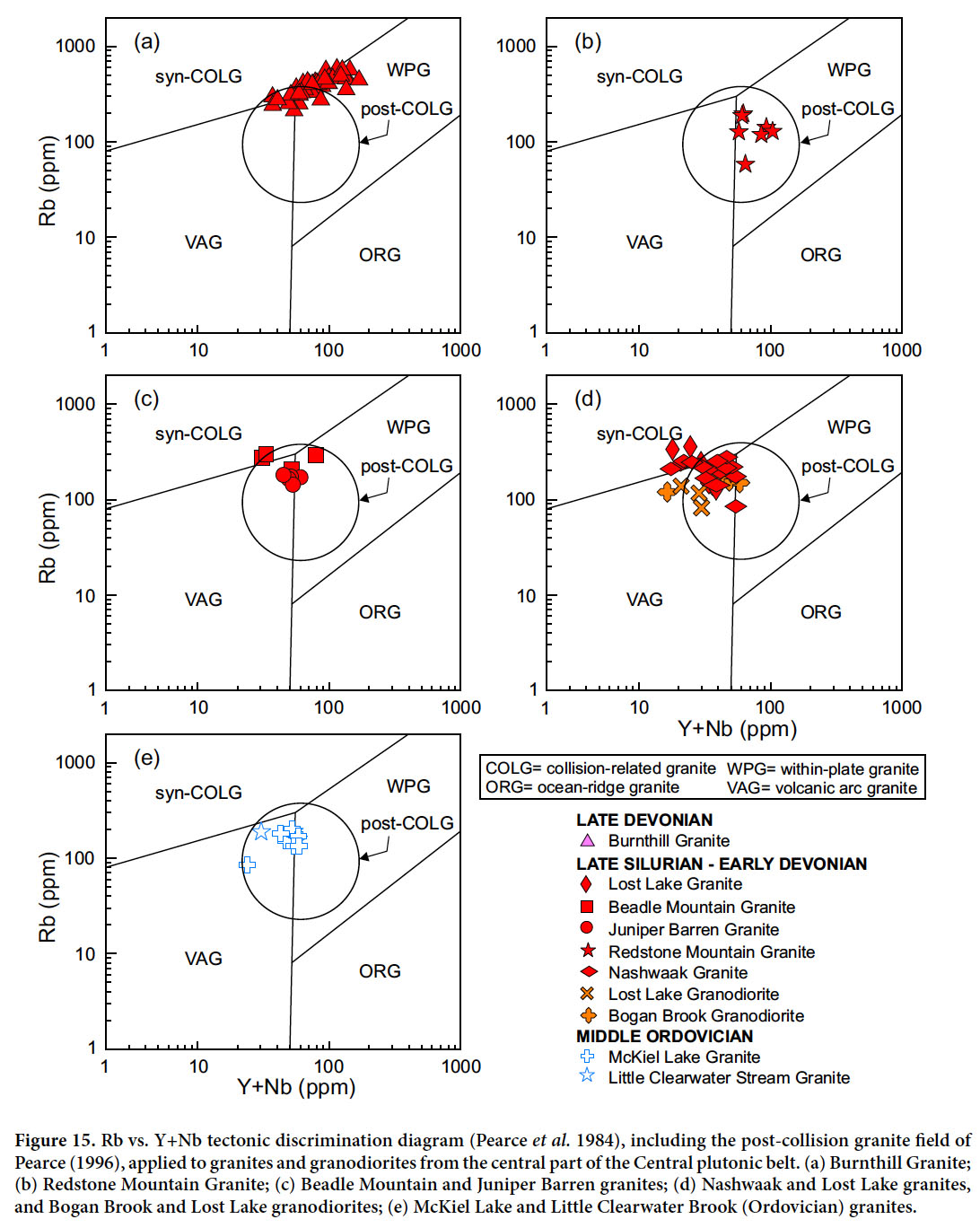 Display large image of Figure 15
Display large image of Figure 15
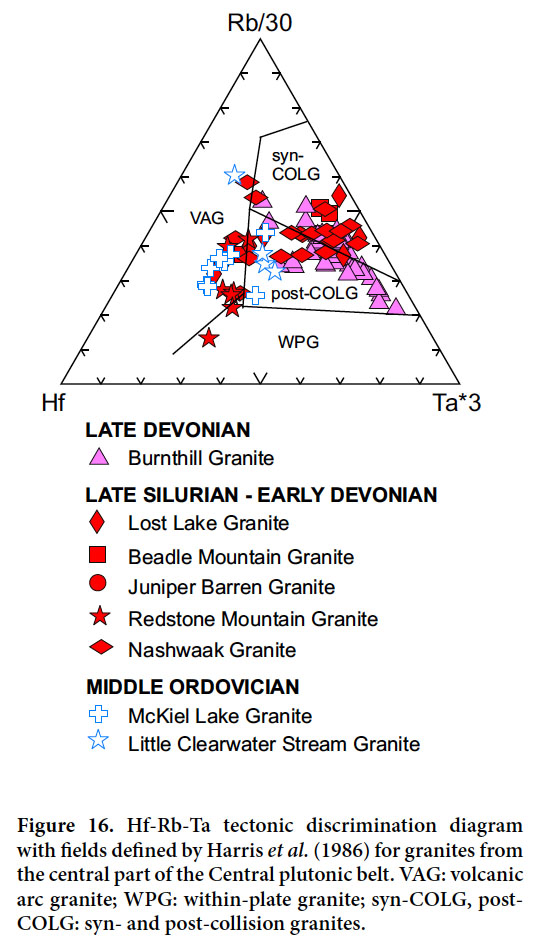 Display large image of Figure 16
Display large image of Figure 16
33 The peraluminous nature of most granite plutons points to a significant supracrustal component in the source; this is supported by the close spatial relationship with the Miramichi Group and Trousers Lake Metamorphic Suite, and the common presence of xenoliths or roof pendants of partially assimilated paragneiss in many plutons. Furthermore, REE profiles of these sedimentary and metasedimentary rocks are very similar to those of most granites (Fig. 14), implying a genetic link. A very similar setting exists in the Gander zone of northeastern Newfoundland, where Silurian–Devonian granites are hosted by correlative sedimentary rocks of the Gander Group and paragneiss and migmatite of the Hare Bay Gneiss (Schofield and D’Lemos 2000). In spite of this, Sr, Nd, and O isotope studies in both New Brunswick and Newfoundland (Kerr et al. 1995; Whalen et al. 1996; Schofield and D’Lemos 2000) agree that no single source or binary mixing product could unequivocally produce the isotopic signatures of the Silurian–Devonian Ganderian granites, and invoke contributions from mantle, infracrustal and supracrustal sources. As pointed out by Pearce (1996), post-collisional granites in particular are difficult to classify because of the range of potential sources, and that, for example, interaction between mantle sources and the crust tend to move compositions into the volcanic arc field on a Rb vs. (Nb + Y) diagram (Fig. 15).
34 Similar Nd isotope compositions and Mesoproterozoic TDM model ages in granites and host (meta)sedimentary rocks in Newfoundland (Kerr et al. 1995; Schofield and D’Lemos 2000) suggest that both are ultimately sourced, at least in part, from a common Ganderian basement. Similarly, Whalen et al. (1996) argued that Silurian−Devonian granites in New Brunswick were likely derived by bulk assimilation of Mesoproterozoic Ganderian basement and Gander zone supracrustal rocks by an enriched asthenospheric melt. The influence of this mantle source is locally seen in gabbros with εNd(T) of +1.2 to +2.3 (Whalen et al. 1996); in the study area, the Clearwater Brook and Becaguimec Lake gabbros (Fig. 1) are interpreted to be the same age as those sampled by Whalen et al. (1996).
35 Whalen et al. (1996) and Schofield and D’Lemos (2000) attributed the heat source that generated Silurian–Devonian granites to the introduction of asthenospheric mantle following either lithospheric delamination of collision-thickened subcontinental lithosphere (e.g., Nelson 1992), or breakoff of the subducting Tetagouche backarc oceanic lithosphere (e.g., Davies and von Blanckenburg 1995). Since both of these scenarios are typically followed by rapid isostatic uplift and gravitational instability, late Silurian exhumation of the Brunswick Subduction Complex and subsequent D3 extensional collapse in the Miramichi Highlands (van Staal and de Roo 1995; van Staal et al. 2003, 2009) could be explained by ca. mid-Silurian breakoff of the Tetagouche slab. However, the Nd isotope geochemistry and TDM model ages of Ganderian granitoid plutons in both New Brunswick and Newfoundland (Kerr et al. 1995; Whalen et al. 1996; Schofield and D’Lemos 2000) do not support the introduction of juvenile asthenospheric material during the late Silurian. This is consistent with Nd isotope data from late Silurian–Early Devonian basalts in northern New Brunswick, where the range in εNd(T) values and depleted mantle ages also argue against the involvement of juvenile asthenospheric mantle in the genesis of the volcanic rocks (Dostal et al. in press). Furthermore, the chemistry of granites from the Central plutonic belt does not match that of slab breakoff-related granitoid suites documented by Hildebrand and Whalen (2014) (Fig. 17).
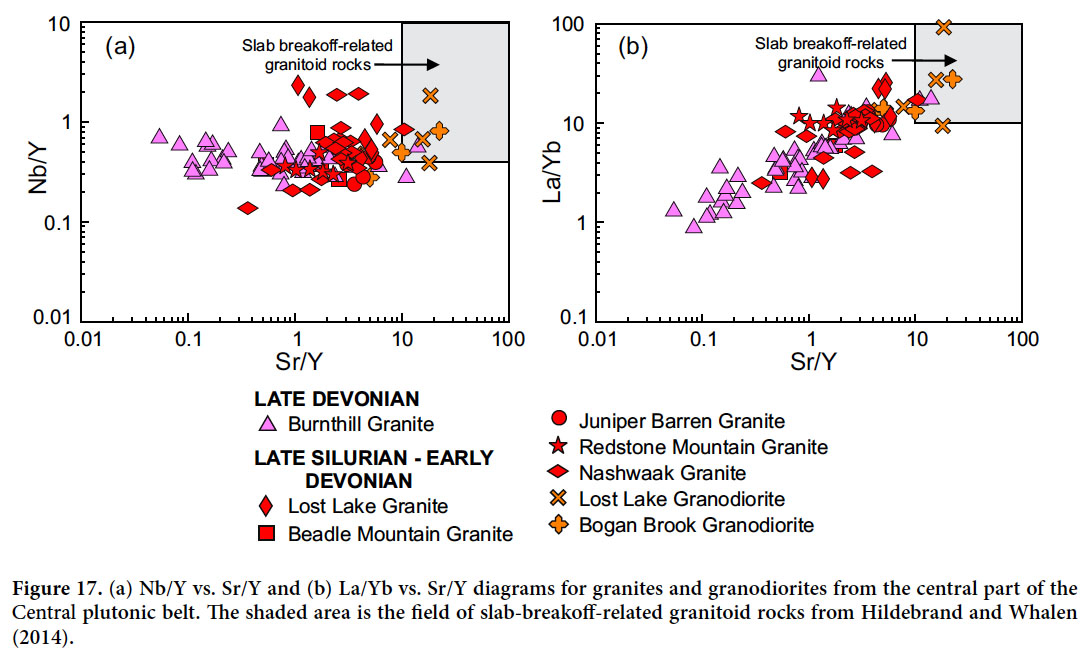 Display large image of Figure 17
Display large image of Figure 17
36 An alternative model put forward by van Staal et al. (2009) invokes westerly, flat-slab subduction of Avalonia beneath composite Laurentia (first proposed by Murphy et al. 1999), analogous to the Laramide orogeny in the western USA, to explain overlapping arc, within-plate, and collisional geochemical signatures, late Silurian–Early Devonian regional uplift, and northwestward (present coordinates) migration of Acadian deformation (cf., Bradley et al. 2000). In New Brunswick, Silurian–Devonian magmatism and Acadian deformation are broadly contemporaneous, ranging from ca. 421 to 407 Ma, based on the ages of plutonic and volcanic rocks (Whalen 1993; Wilson et al. 2005; Wilson and Kamo 2008, 2012; this study) and eastward extrapolation of successive Devonian positions of the Acadian deformation front (Bradley et al. 2000). Hence, as pointed out by van Staal et al. (2009), Acadian magmatism is more closely associated with crustal shortening than with regional extension or lithospheric delamination. The van Staal et al. (2009) model proposes that asthenospheric “pockets” inherited from Salinic backarc extension and slab break-off became trapped above the Acadian (Avalonian) flat slab; dehydration of the Acadian slab and fluid fluxing of the mantle pockets then generated partial melts having mixed arc and within-plate signatures, and may account for the mantle-derived component of Ganderian granitoid plutons inferred by Kerr et al. (1995), Whalen et al.(1996), and Schofield and D’Lemos (2000). However, granitoid rocks from the study area do not exhibit the high (La/Yb)CN values that van Staal et al. (2009) reported for many Devonian plutonic rocks from Gaspé and New Brunswick (their figure 19) and cited as characteristic of Andean flat-slab subduction. Finally, the trapped asthenospheric mantle probably ponded at the base of the crust, unable to ascend because the orogen was under compression, and provided the heat source for large-scale crustal melting that generated the bulk of granitic magma in the Central plutonic belt.
ECONOMIC POTENTIAL
37 Economic concentrations of Sn, W, Mo, Sb, Be, etc. are normally associated with highly evolved intrusive phases representing the late-stage, fluid- and incompatible element-enriched apical zones of large magma chambers. Strongly differentiated granites are characterized by elevated Rb at the expense of Ba and Sr (e.g., see Fig. 11a), so that Rb/Ba and Rb/Sr ratios have been used as estimators of the Sn, W, or Mo-bearing potential of granitic rocks (Tauson and Kozlov 1973; Neiva 1984; Ng et al. 2015). Ternary diagrams illustrating relative abundances of Ba, Rb, and Sr are therefore useful in identifying the most fractionated granites, which are normally those that carry the greatest Sn endowment (Fig. 18). As pointed out by Lehmann (1987), the “geochemical heritage” of Sn-mineralized granites can be as little as 5–10 ppm Sn; in view of this, samples containing greater than 10 ppm Sn are regarded as Sn-enriched and have been highlighted on Figure 18. Although most of these samples plot in the “strongly differentiated granite” field of El Bouseily and El Sokkary (1975) and Neiva (1984) (Fig. 18), a few Sn-enriched granites lie outside that field, and conversely, some samples containing <10 ppm Sn are included within it. Hence, the diagram is not an infallible method of identifying Sn-mineralized granite, but it does confirm the highly evolved character of several of the plutons in the study area.
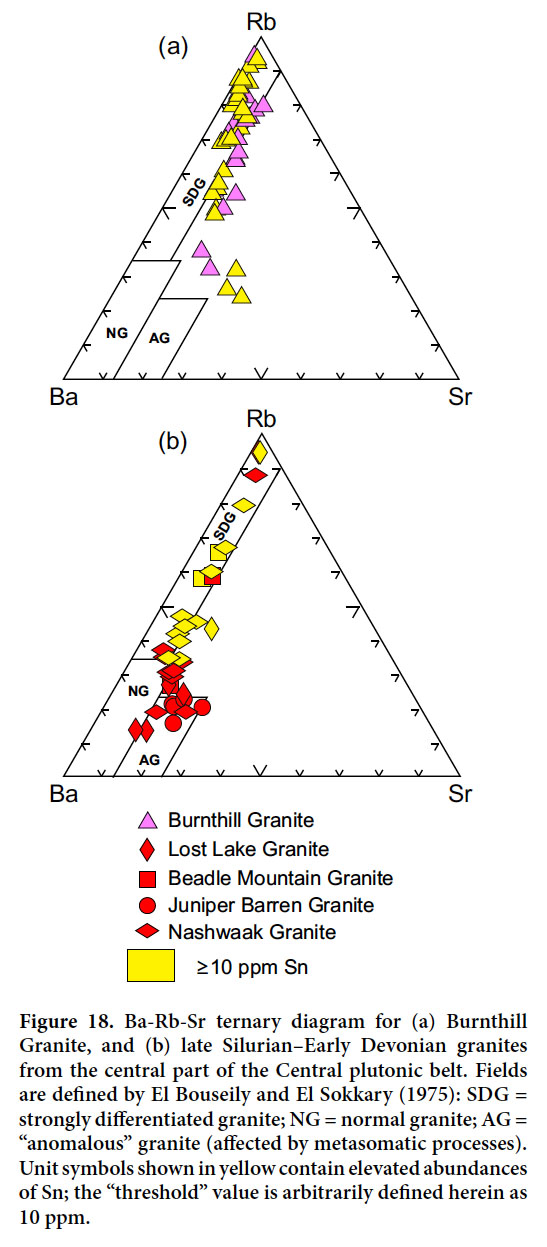 Display large image of Figure 18
Display large image of Figure 18
38 Another measure of granite evolution and metal-bearing potential that has been shown to be applicable in some areas (e.g., Chatterjee and Muecke 1982) is the ratio of Th to U and how it varies with increasing magmatic differentiation. Plots of Th/U vs. Mg# and Th/U vs. SiO2 (Fig. 19) demonstrate that in many of the granites in the Central plutonic belt, Th/U is directly correlated with Mg# and inversely correlated with SiO2; i.e., lower Th/U is associated with increasing degrees of granite evolution. Exceptions are the Redstone Mountain Granite, which has a narrow range of Th/U (Figs. 19d, 19h) that is unaffected by variation in Mg# or SiO2, and some samples of the Nashwaak Granite that appear to constitute a separate population (“Nashwaak group 2”; Figs. 19d, 19h). Similarly, all Silurian−Devonian granites except for the Redstone Mountain and group 2 of the Nashwaak population consistently illustrate an increase in Sn with decreasing Th/U (Fig. 20) (Th/U is employed as an index of granite evolution because the Burnthill and Nashwaak granites show poor correlation between Sn and Mg# and between Sn and SiO2).
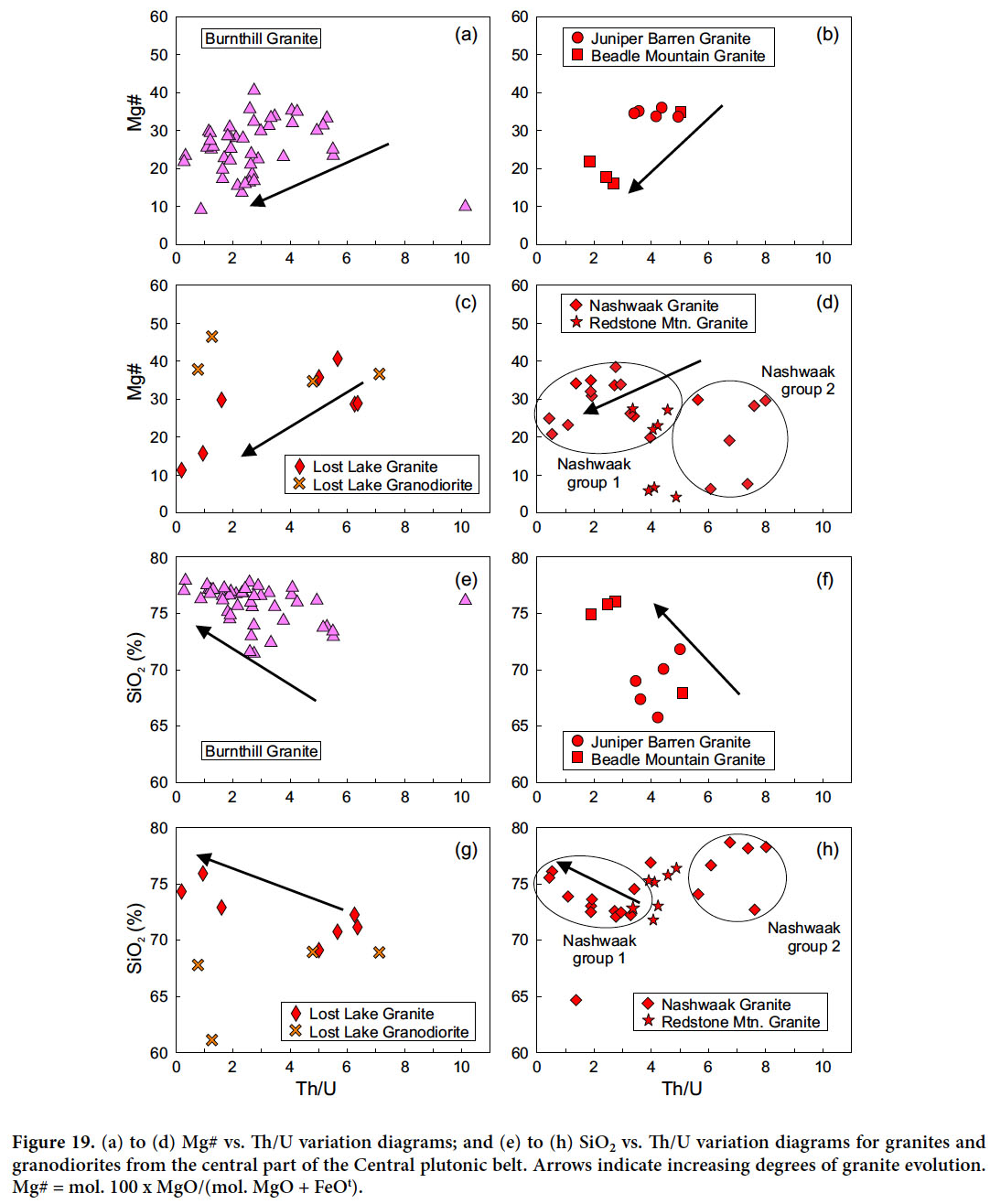 Display large image of Figure 19
Display large image of Figure 19
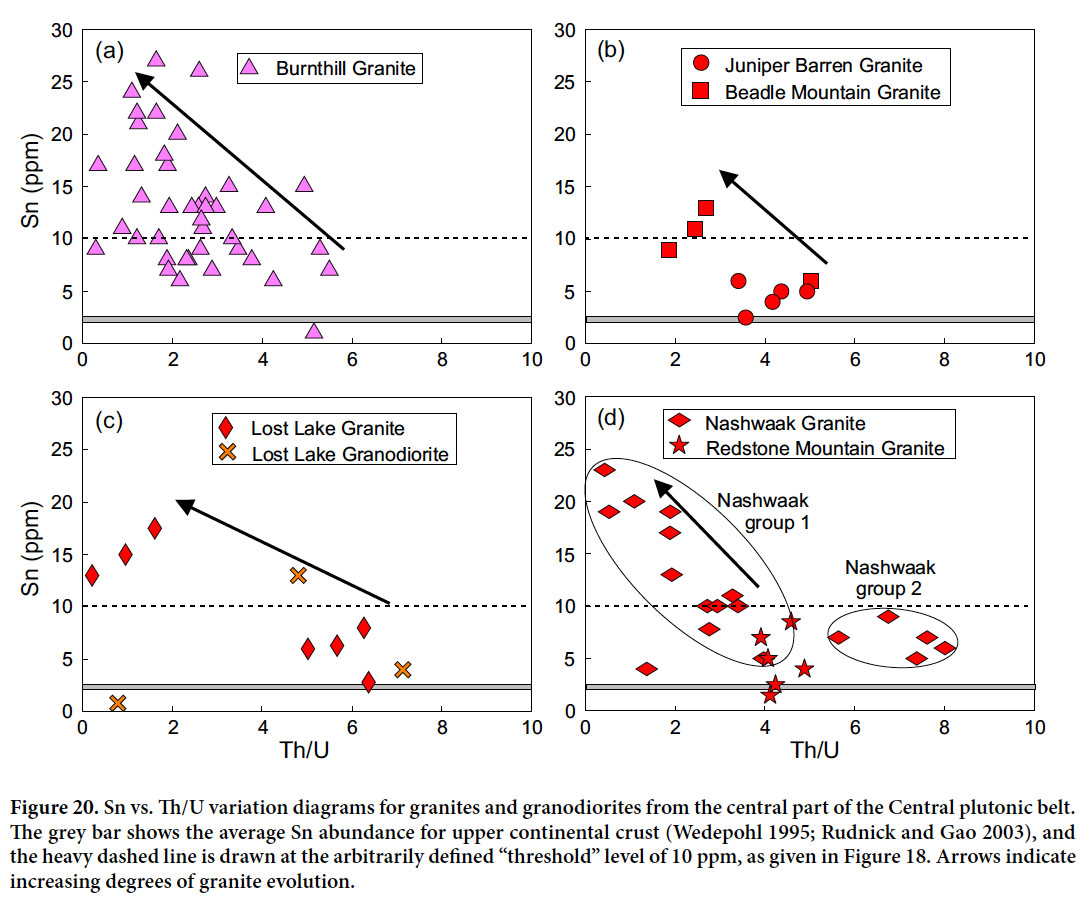 Display large image of Figure 20
Display large image of Figure 20
39 Compared to average values for Upper Continental Crust (Wedepohl 1995; Rudnick and Gao 2003), granites and granodiorites from the study area, and especially the Silurian and Devonian granites, are enriched in Be, Cs, P, Rb, Sn, Th, U and W, and depleted in Ba, Sc, Sr, V, and Zr. As shown by numerous workers, highly-evolved, Sn-specialized granites typically exhibit these enrichments and depletions, along with elevated abundances of F, Li, Nb, and Ta (Olade 1980; Chatterjee and Muecke 1982; Edén 1991; Förster et al. 1999). In most cases, some of which are illustrated in Figures 21 and 22, these trends are evident in granites from the study area. For example, the Th/U index of granite evolution is negatively correlated with Rb and Cs (Fig. 21) and positively correlated with Ba and La (Fig. 22). The Nashwaak Granite data again suggest the presence of two populations; for example, group 1 shows a decrease in Ba and La with decreasing Th/U, whereas group 2 forms an antithetic trend (Figs. 22d, 22h).
 Display large image of Figure 21
Display large image of Figure 21
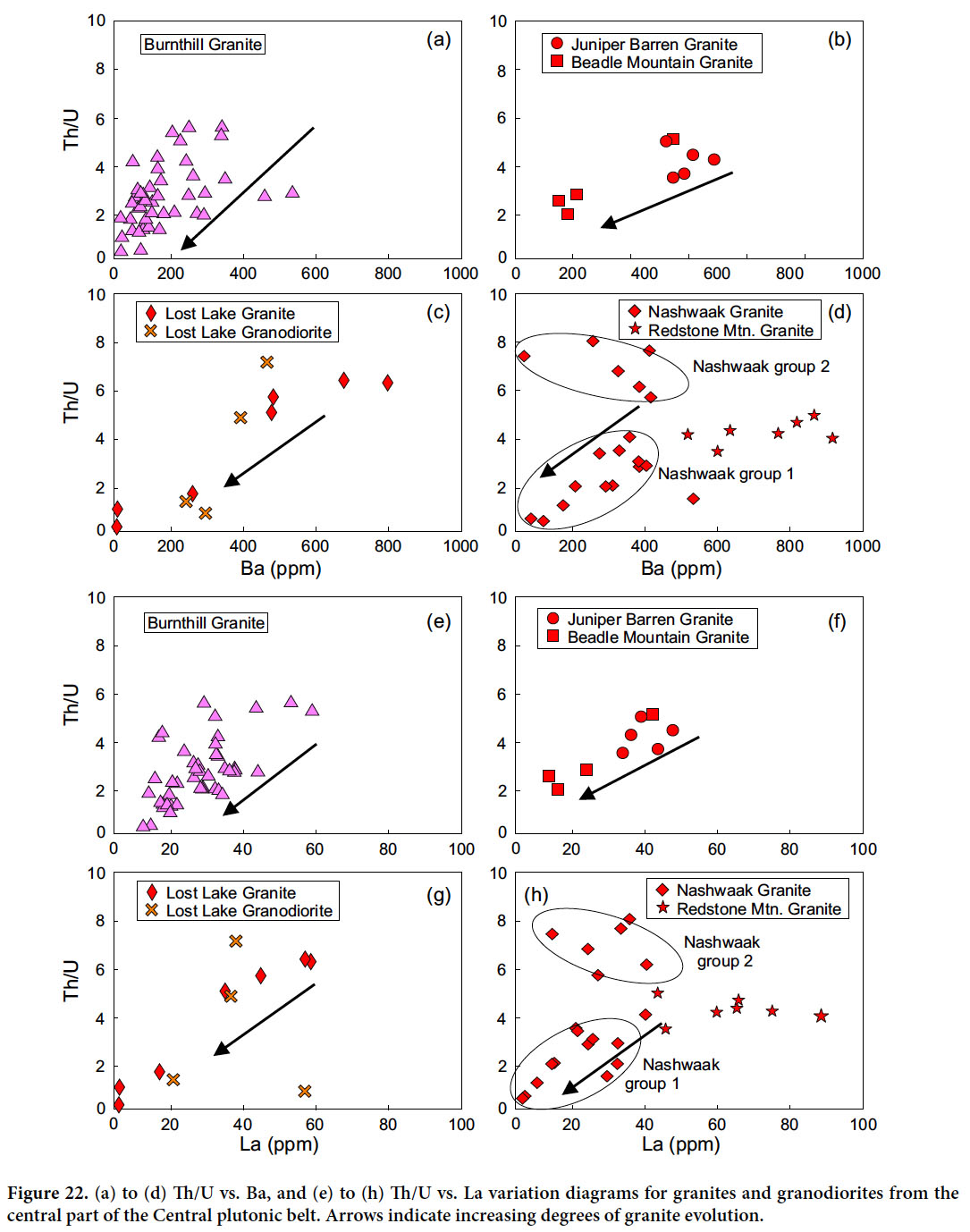 Display large image of Figure 22
Display large image of Figure 22
40 All plutons from the study area contain average Sn abundances in excess of the upper continental crustal average of 2.1–2.5 ppm (Wedepohl 1995; Rudnick and Gao 2003) (Table 4 and Fig. 20). The highest average values are present in the Burnthill, Nashwaak, Lost Lake, and Beadle Mountain granites, accompanied by maximum abundances of 31, 23, 17.5, and 13 ppm Sn, respectively. Although there is a wide range in the average Sn content of granites associated with tin deposits, the latter figures compare well with those reported for Sn-specialized granites in various “tin belts” world-wide, e.g., Malaysia (~7–40 ppm; Ishihara and Terashima 1974; Ng et al. 2015), Thailand (7.7–20.0 ppm; Ishihara et al. 1980), Bolivia (~7–29 ppm; Lehmann et al. 1990), Nigeria (~22 ppm; Olade 1980), and Nova Scotia (~50 ppm; Chatterjee et al. 1983). Furthermore, most of the New Brunswick plutons are poorly exposed, and have not been sampled systematically; highly evolved phases or cupolas containing greater enrichment in Sn (or W or Mo) may therefore locally underlie the surficial cover.
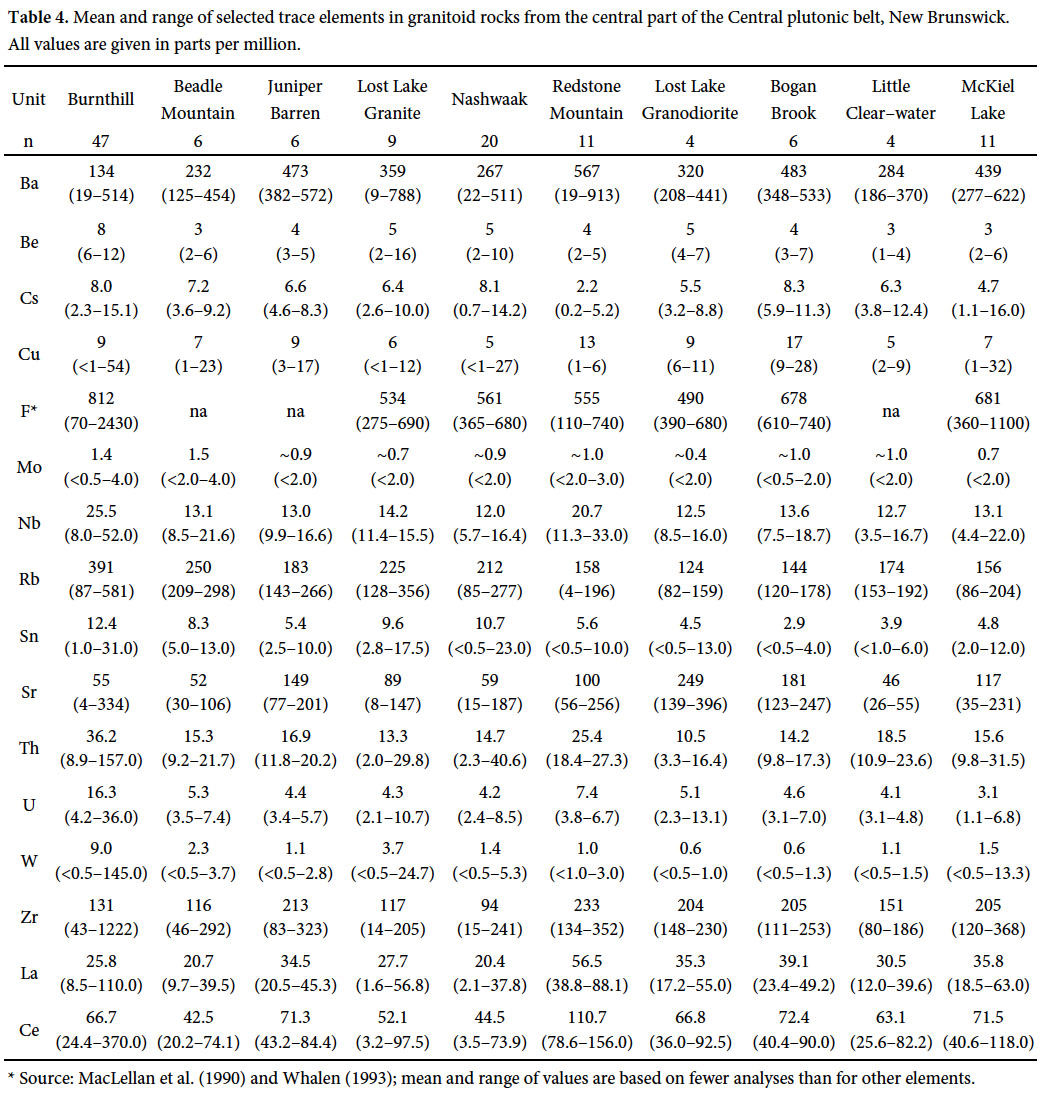 Display large image of Table 4* Source: MacLellan et al. (1990) and Whalen (1993); mean and range of values are based on fewer analyses than for other elements.
Display large image of Table 4* Source: MacLellan et al. (1990) and Whalen (1993); mean and range of values are based on fewer analyses than for other elements. 41 The Burnthill Granite (and cogenetic plutons east of the area shown on Figure 1) is associated with exo- and endogranitic W, Mo, Sn, and Be mineralization (Fig. 1) and hosts the greatest average abundances of Sn, W, Be, F, Cs, Th, and U (Table 4). Almost all samples of Burnthill Granite contain Sn in excess of 5 ppm (Fig. 20a); in addition, about 30% of Burnthill samples contain greater than 5 ppm W, up to a maximum of 145 ppm. The Lost Lake Granite contains up to 17.5 ppm Sn, 24.7 ppm W, and 16 ppm Be, whereas the Beadle Mountain Granite contains up to 13 ppm Sn, 3.7 ppm W, and 4 ppm Mo (Table 4). W-Mo mineralization at the Sisson deposit is located near the contact with the Nashwaak Granite (Fyffe and Thorne 2010; McClenaghan et al. 2014); however, an actual genetic link with the Nashwaak Granite is doubtful, given that recent Re-Os (molybdenite) dating of Sisson mineralization has yielded an age of ca. 378 Ma (Zhang 2015), consistent with an 40Ar/39Ar age of 379 Ma on the host Howard Peak Granodiorite (Taylor et al. 1987). Nevertheless, the Nashwaak Granite features the second-highest average Sn abundance (10.7 ppm), ranging to a maximum of 23 ppm Sn, along with 5.3 ppm W and 10 ppm Be. Most of the samples containing elevated Sn are located in the northern part of the pluton, between McKiel Brook and McKiel Lake (Fig. 1), where the biotite − muscovite phase of the granite is predominant. However, there is no correlation between this Sn-enriched cluster and one of the two populations suggested by the sample distributions in Figures 19d, 19h, 22d, and 22h.
42 An isolated sample of granite (TD-11-3; Fig. 1) featuring anomalous concentrations of several elements of economic interest is located adjacent to the Catamaran Brook Fault, where it lies within a small stock thought to be related to the Redstone Mountain Granite about 4 km to the north (Crouse 1978; Smith and Fyffe 2006b). This sample contains 131 ppm Sn, 34 ppm W, 17 ppm Mo, ~10 ppm Cs, 115 ppm Cu, ~32 ppm Bi, 35 ppm As, 50 ppm Th, and ~25 ppm U (Appendix B). However, it is not known whether this mineralization is a magmatic deposit related to a granite cupola, or sourced from mineral-bearing fluids associated with the Catamaran Brook Fault.
SUMMARY
43 Plutonic rocks in the central part of the Central plutonic belt can be divided into three groups based on age of emplacement/crystallization: (1) late Early to Middle Ordovician (Little Clearwater Brook and McKiel Lake granites); (2) late Silurian to Early Devonian (Lost Lake, Beadle Mountain, Juniper Barren, Nashwaak and Redstone Mountain granites, and the Bogan Brook and Lost Lake granodiorites); and (3) Late Devonian (Burnthill Granite). CA-ID-TIMS U-Pb (zircon) dating yields a late Early to Middle Ordovician age of 467 ± 7 Ma for the McKiel Lake Granite; late Silurian ages of 423.2 ± 3.2 Ma and 420.7 +1.8/-2.0 Ma for the Bogan Brook Granodiorite and Nashwaak Granite, respectively; a 419 ± 0.5 Ma age that straddles the Silurian–Devonian boundary for the Redstone Mountain Granite; Early Devonian ages of 416.1 ± 0.5 Ma, 415.8 ± 0.3 Ma, and 409.7 ± 0.5 Ma for the Beadle Mountain, Juniper Barren, and Lost Lake granites, respectively; and a Late Devonian age of 380.6 ± 0.3 Ma for the Burnthill Granite.
44 Plutons of all ages show marked chemical similarities on major and trace element variation diagrams. All are predominantly calc-alkalic, weakly to moderately peraluminous, S-type granites, although the Burnthill Granite and Redstone Mountain Granite display mixed S- and I-type characteristics. Except for the less evolved Juniper Barren Granite, Silurian−Devonian plutons in the study area are mainly silica-rich, evolved granites with average Mg#s ranging from 18 to 28 (Table 3). They display mixed arc and within-plate affiliation, but tend to cluster in syn- to post-orogenic fields on tectonic discrimination diagrams (Figs. 7, 15, 16); Ordovician granites also display mixed continental arc and within-plate affinities, probably because they were associated with extension of the Popelogan arc and incipient (Tetagouche) back-arc rifting in a lower crustal region “contaminated” by prior subduction. The unique geochemical characteristics of the Burnthill Granite have been interpreted as being related to post-melting petrogenetic processes, e.g., a high degree of crystal fractionation, rather than to the source (Whalen 1993); Sn and W deposits and occurrences are attributed to hydrothermal processes such as aqueous phase saturation and fluid separation (MacLellan and Taylor 1989). In contrast, the Redstone Mountain Granite is chemically more typical of within-plate magmatism, and forms a bimodal association with spatially-related mafic intrusive rocks. It is also interpreted as the subvolcanic source of coeval felsic volcanic rocks of the nearby Costigan Mountain Formation (Walker and Clark 2012).
45 Lithogeochemical data such as trace element ratios and REE profiles, as well as Nd, O, and Pb isotope systematics (Whalen et al. 1996, 1998) show that Ordovician and Silurian–Devonian granites were derived from geochemically and isotopically similar protoliths. The voluminous magmas responsible for late Silurian–Early Devonian plutonism were probably generated as a result of crustal thickening following the ca. 430 Ma collision of Ganderia and composite Laurentia, and/or underthrusting of Ganderia’s trailing edge by the leading edge of Avalonia, which (a) generated mixed arc and within-plate-type melts above the dehydrating slab, and (b) trapped pockets of asthenospheric mantle against the base of the crust, leading to large-scale crustal melting (van Staal et al. 2009).
46 All granites in the central part of the Central plutonic belt show at least some enrichment in Sn compared to global average granite, and in several cases contain Sn in amounts comparable to tin-productive granites in other parts of the world. The greatest enrichment occurs in the most evolved felsic plutons, i.e., the Burnthill, Lost Lake, Nashwaak, and Beadle Mountain granites. This specialization in Sn is accompanied by enrichments in elements such as Rb, Cs, Be, W, and P, high Rb/Sr, low Th/U, and depletions in Sr, Ba, REE, Sc, and Zr, which are considered proxies for potential economic mineralization in other granophile elements such as Mo and W. Anomalous abundances of W are present in some samples of the Burnthill, Lost Lake, Nashwaak and even the Ordovician McKiel Lake Granite, although Ordovician plutons, except for the arc-type Gibson and Benton plutons in the Woodstock area (Fig. 1), are not known to be associated with mineralization. The Juniper Barren, Lost Lake and Nashwaak granites are, in large part, poorly exposed, and it is possible that mineralized cupolas are present but as yet undetected. The data presented herein indicate that thorough and systematic lithogeochemical analyses can provide an effective vector to potential granophile-element mineralization.
Field mapping and sample collection in the Central plutonic belt were carried out by S.H. McClenaghan. Kathleen Thorne and Jim Walker are thanked for their reviews of early versions of the manuscript. The paper was greatly improved by comments and suggestions from journal reviewers Joe Whalen and Andy Kerr.
APPENDIX A: ANALYTICAL METHODS
Geochronology
47 U-Pb analyses were performed at the Jack Satterly Geochronology Laboratory in the Department of Earth Sciences, University of Toronto, by isotope dilution thermal ionization mass spectrometry (ID-TIMS) methods. Rocks were crushed and pulverized using standard methods with a jaw crusher and disk mill. A Wilfley table was used to produce a concentrate of heavy minerals. Zircon was isolated using methylene iodide and a Frantz magnetic separator. Prior to dissolution, zircon grains were chemically abraded to penetratively remove alteration zones where Pb loss has occurred (Mattinson 2005). These zones correlate with areas of high U that have suffered radiation damage prior to alteration. To thermally anneal damaged lattice sites, grains were placed in a muffle furnace at ~1000°C for up to 60 h. This was followed by partial dissolution in 50% HF and ~10 µl 8N HNO3 in Teflon dissolution vessels at 195°C for ~17 hours. The grains were washed in 8N HNO3 prior to dissolution. A mixed 205Pb-233-235U spike (ET535 tracer from the EARTHTIME Project) was added to the Teflon dissolution capsules during sample loading. The zircon was dissolved using ~0.10 mL of concentrated hydrofluoric acid (HF) and ~0.02 mL of 8N nitric acid (HNO3) at 195°C (Krogh 1973) for ~5 days, then dried to a precipitate, and re-dissolved in ~0.15 mL of 3N hydrochloric acid (HCl). U and Pb were isolated from the zircon solutions using anion exchange chromatography, then dried in dilute phosphoric acid (H3PO4), and deposited onto outgassed rhenium filaments with silica gel (Gerstenberger and Haase 1997). Pb was analyzed with a VG354 mass spectrometer in dynamic mode with a Daly pulse-counting system. U was measured using the Daly detector or in static mode using three Faraday collectors. Corrections for isobaric interferences from 233UO16O18 on 235UO2 at mass 267 have been made. The dead time of the Daly measuring system for Pb and U was 16.5 and 14.5 ns, respectively. The mass discrimination correction for the Daly detector is constant at 0.05%/atomic mass unit. Daly characteristics were monitored using the SRM 982 Pb standard. Thermal mass fractionation for Pb was 0.1% per atomic mass unit, and that for U was measured and corrected within each cycle. The total common Pb in each zircon analysis was attributed to laboratory Pb (corrected using an isotopic composition of 206Pb/204Pb of 18.49 ± 0.4%, 207Pb/204Pb of 15.59 ± 0.4%, 208Pb/204Pb of 39.36 ± 0.4%; 2σ uncertainties), thus no correction for initial common Pb from geological sources was made. Routine testing indicates that laboratory blanks for Pb and U are usually contain less than 0.5 pg and 0.01 pg, respectively. Corrections to the 206Pb/238U and 207Pb/206Pb ages for initial 230Th disequilibrium were made assuming a Th/U ratio in the magma of 4.2. Decay constants are those of Jaffey et al. (1971). All age errors quoted in the text and tables, and error ellipses in the concordia diagrams are given at 2σ. Plotting and age calculations are from Isoplot/Ex 3.00 (Ludwig 2003).
Lithogeochemistry
48 Sixty-eight samples of fresh, unaltered granite and granodiorite from ten plutons were submitted for lithogeochemical analysis at Activation Laboratories Ltd. in Ancaster, ON. Samples were subjected to lithium metaborate/tetraborate fusion and the resulting molten bead digested in a weak nitric acid solution. Analyses were carried out by inductively-coupled plasma optical emission spectrometry (major oxides, Ba, Be, Sc, Sr, and V), and inductively-coupled plasma mass spectrometry (Bi, Co, Cs, Ga, Ge, Hf, In, Mo, Nb, Rb, Sn, Ta, Tl, U, W, Y, Zr, and rare-earth elements). Silver, Cd, Cu, Ni, Pb, S, and Zn were analyzed by multi-acid digestion and inductively-coupled plasma mass spectrometry, and As, Au, Cr, Sb, and Th by instrumental neutron activation analysis.
49 Twelve repeat analyses of an internal granite standard yielded excellent to very good repeatability for major oxides (average <2% variation, except 5.8% for P2O5 ) and most reported trace elements (0–10%), except for Cu, Ge, Nb, Pb (10–20% variation) and Ag, As, Bi Sb, and W (>20% variation). Analytical methods, precision and accuracy for data incorporated from the other sources cited in this paper are given by Whalen (1993) and MacLellan and Taylor (1989). Although the analytical methods used to acquire the older data (mainly X-Ray Fluorescence Spectroscopy and Instrumental Neutron Activation Analysis) differ from those used in this study, the high quality of the older data (based on the labs used, the precision and accuracy figures reported by Whalen (1993) and MacLellan and Taylor (1989), and the congruity of old and newly acquired data when plotted on variation/discrimination diagrams) supports the use of a combined dataset.
APPENDIX B
 Display large image of Appendix B
Display large image of Appendix B